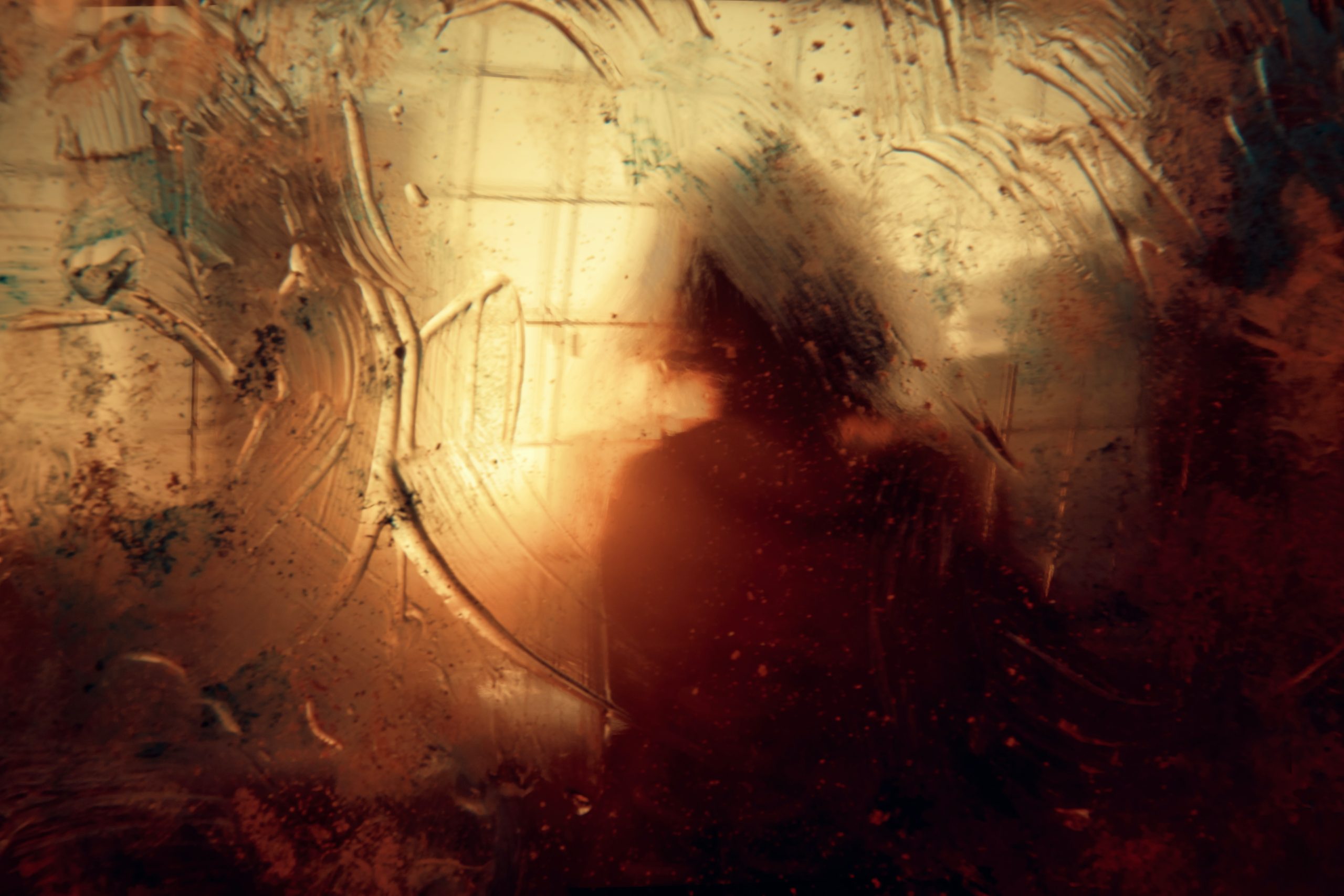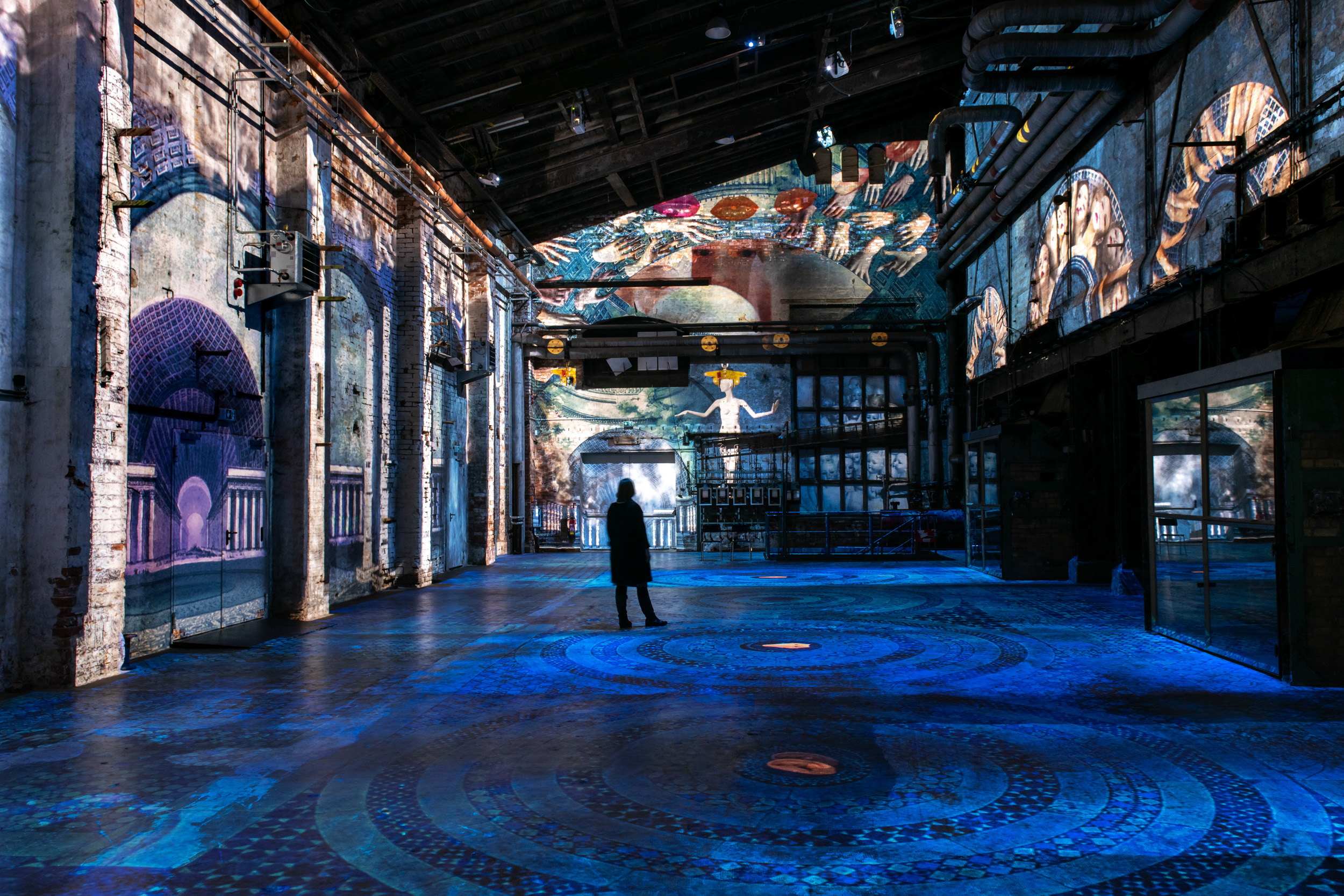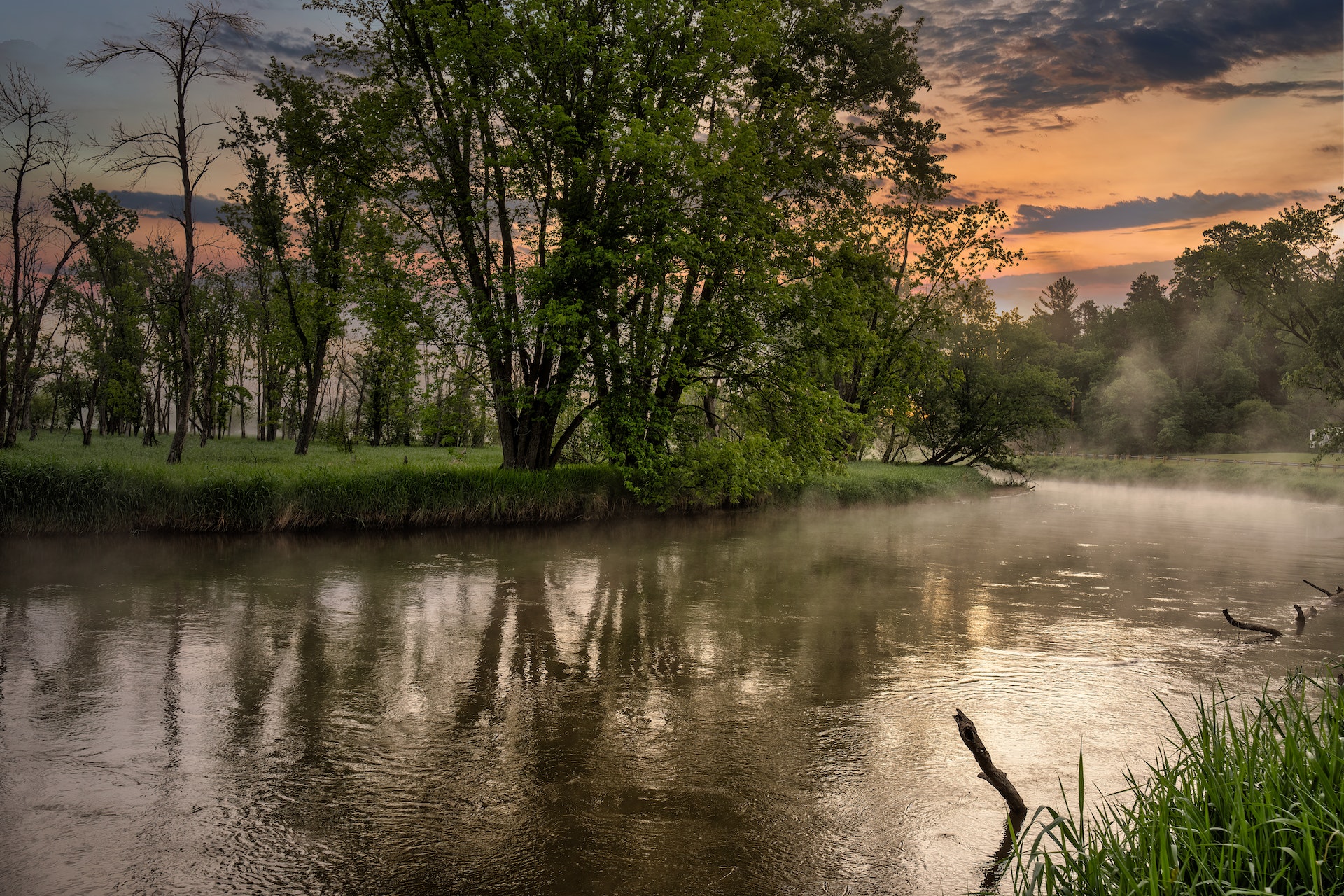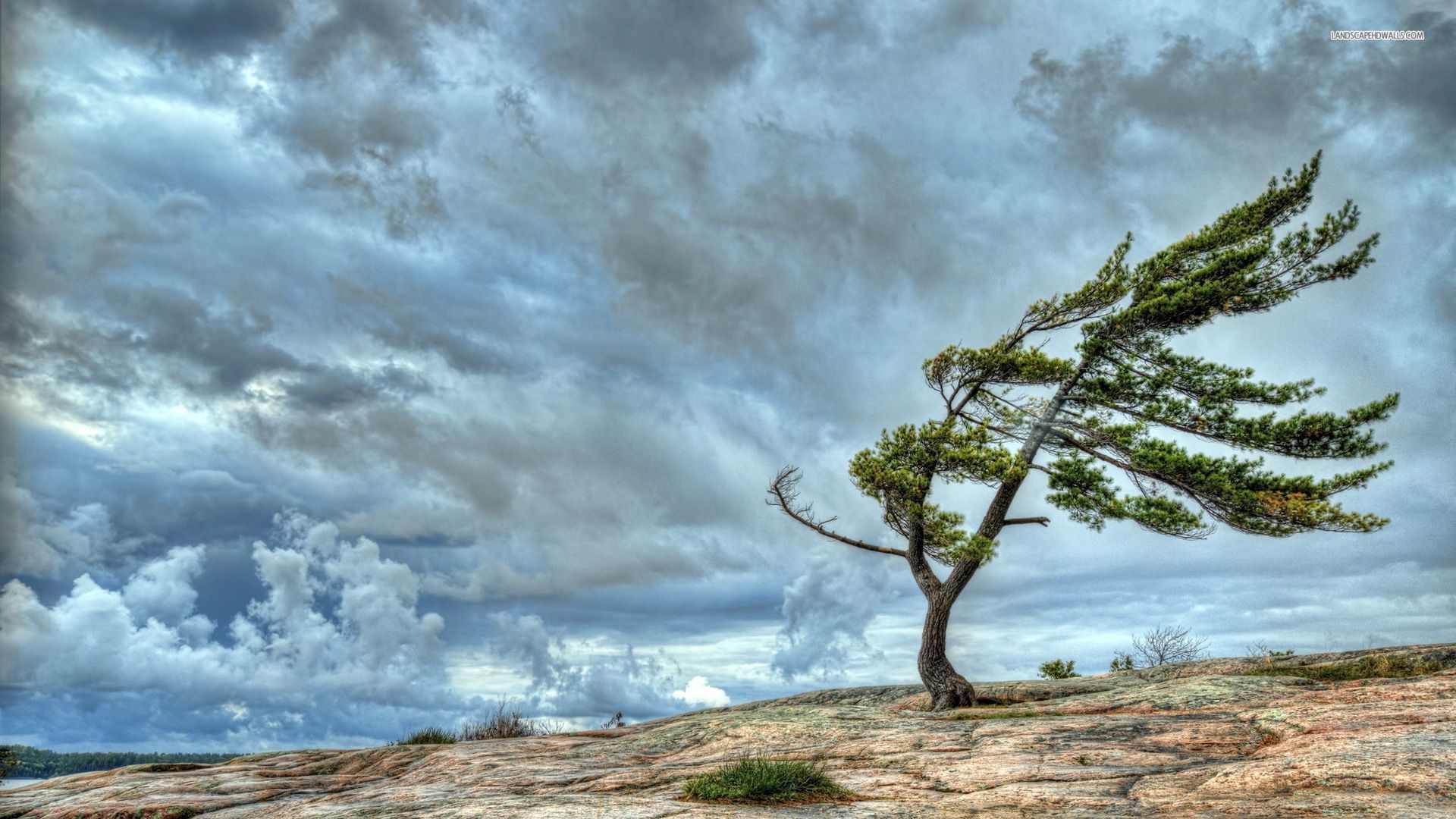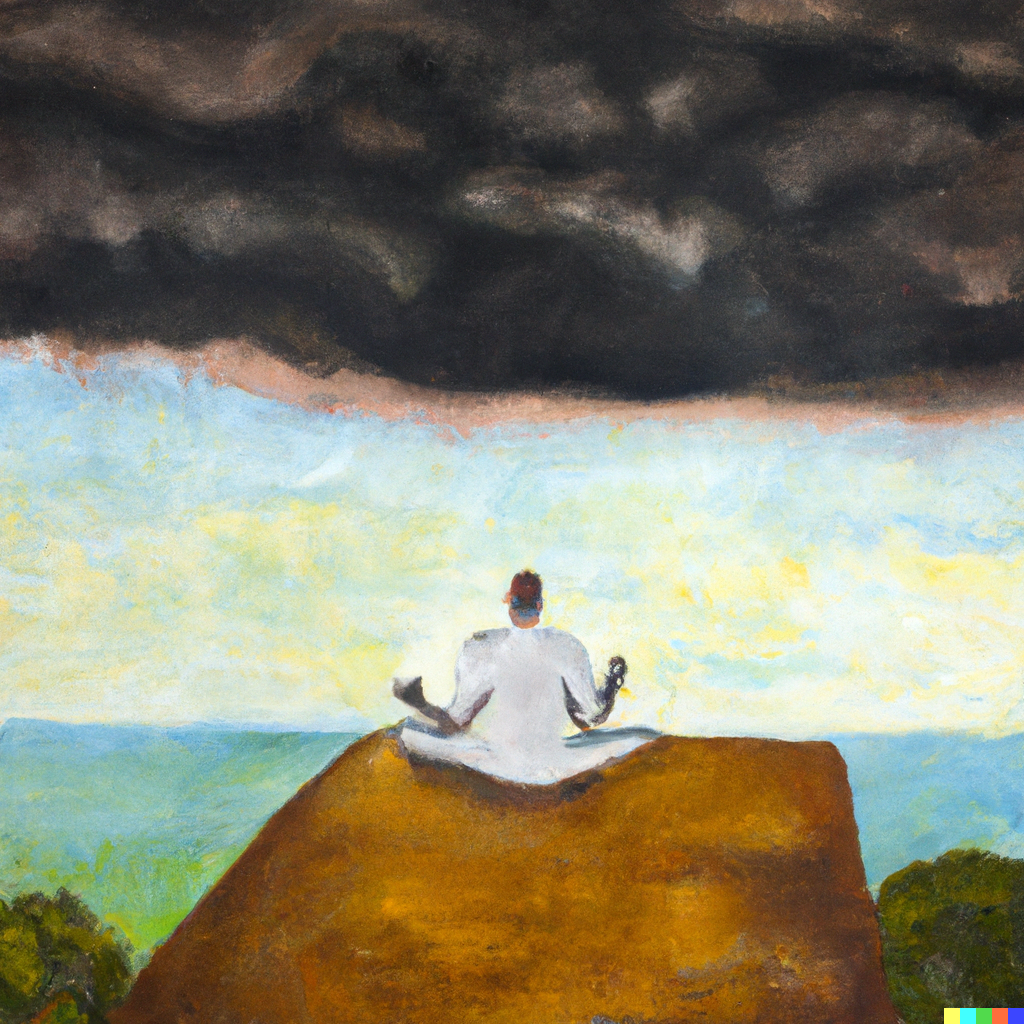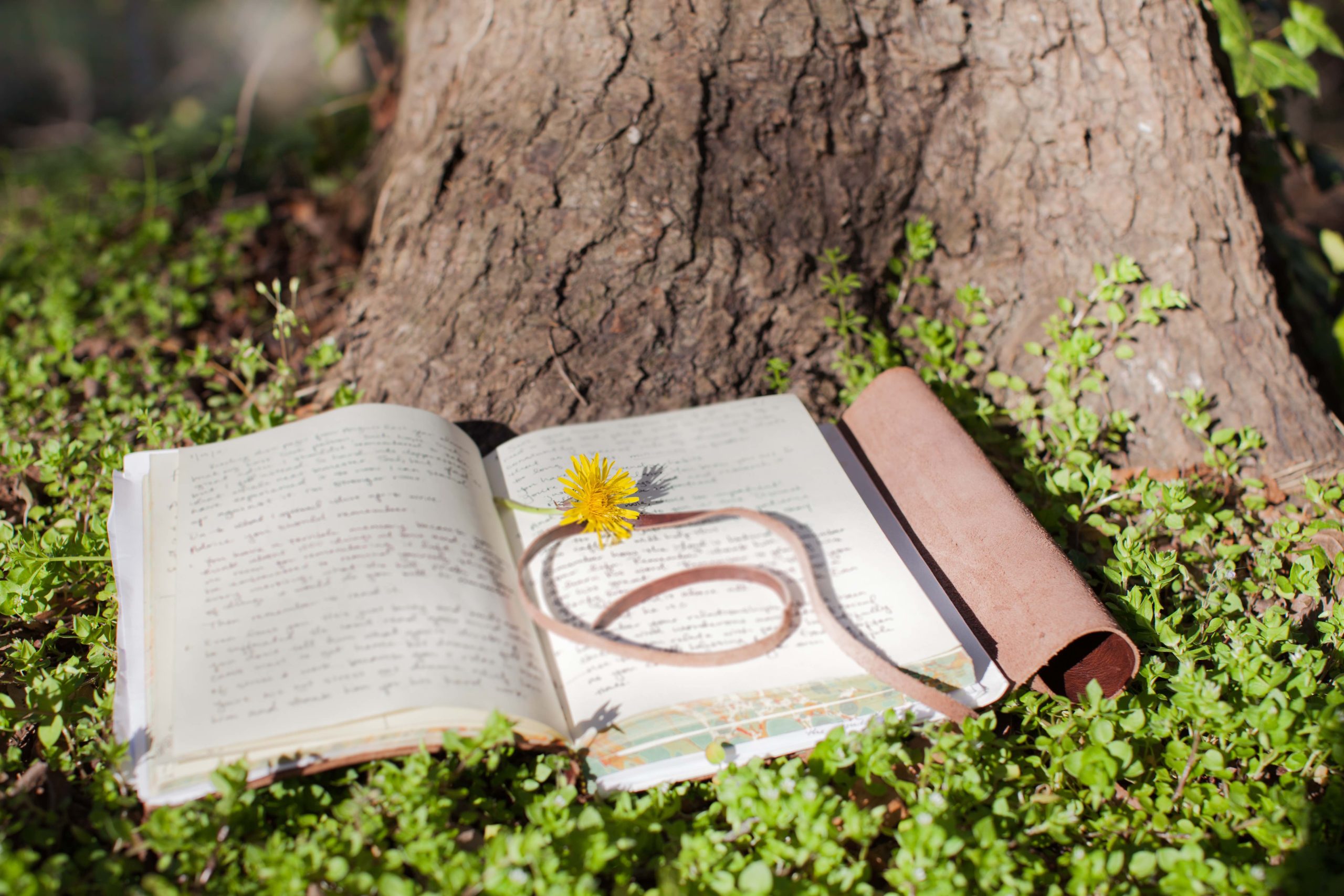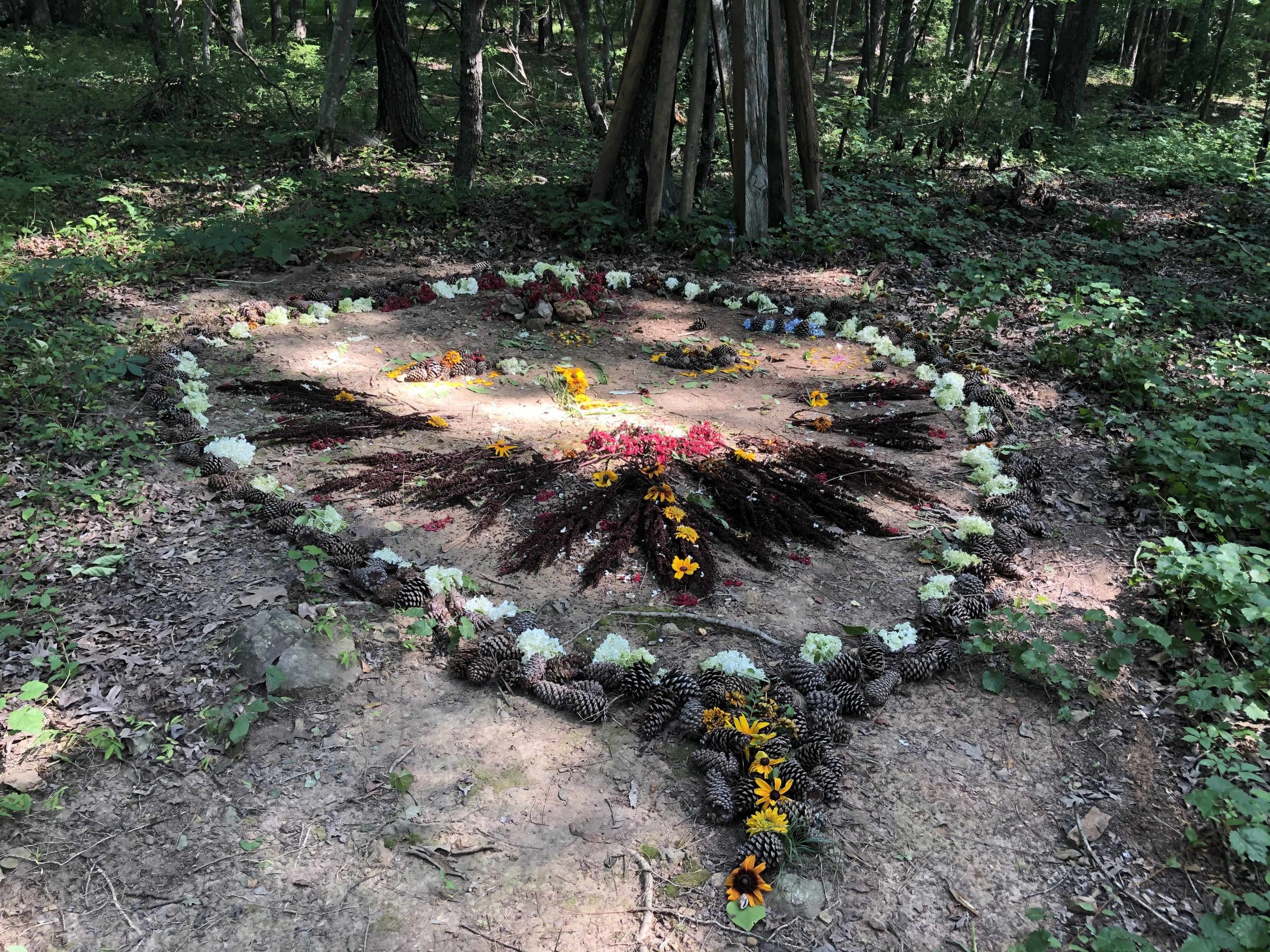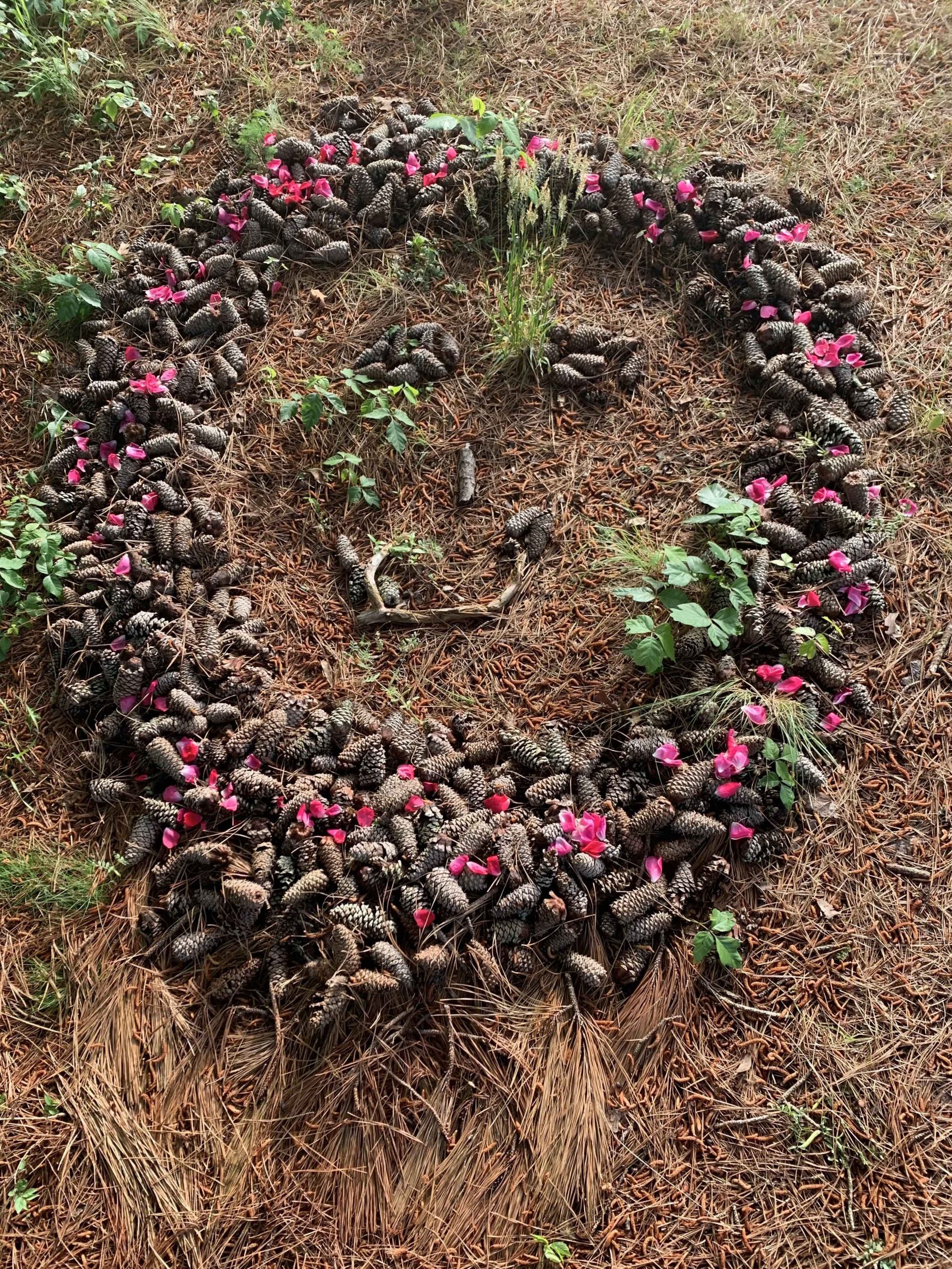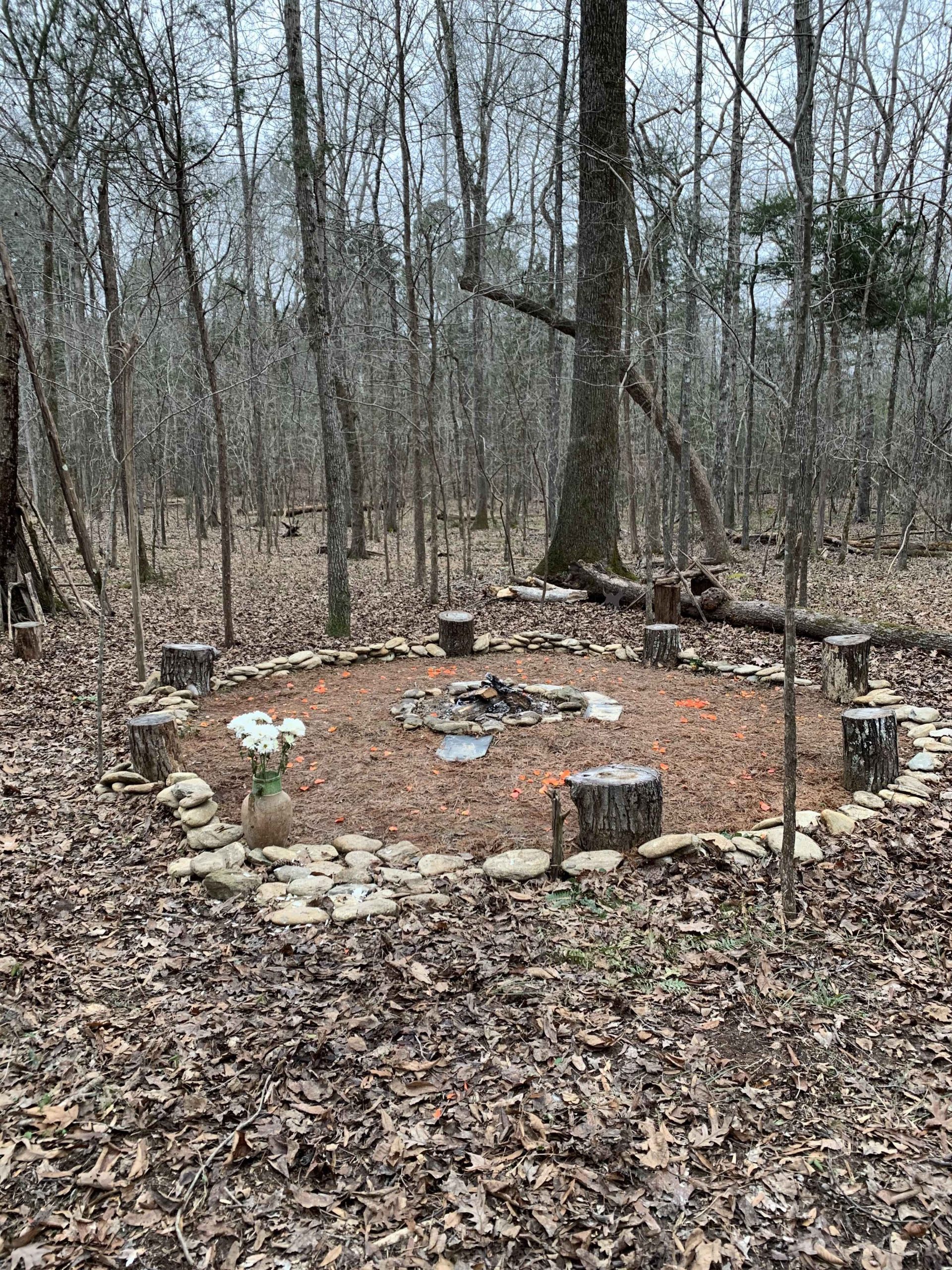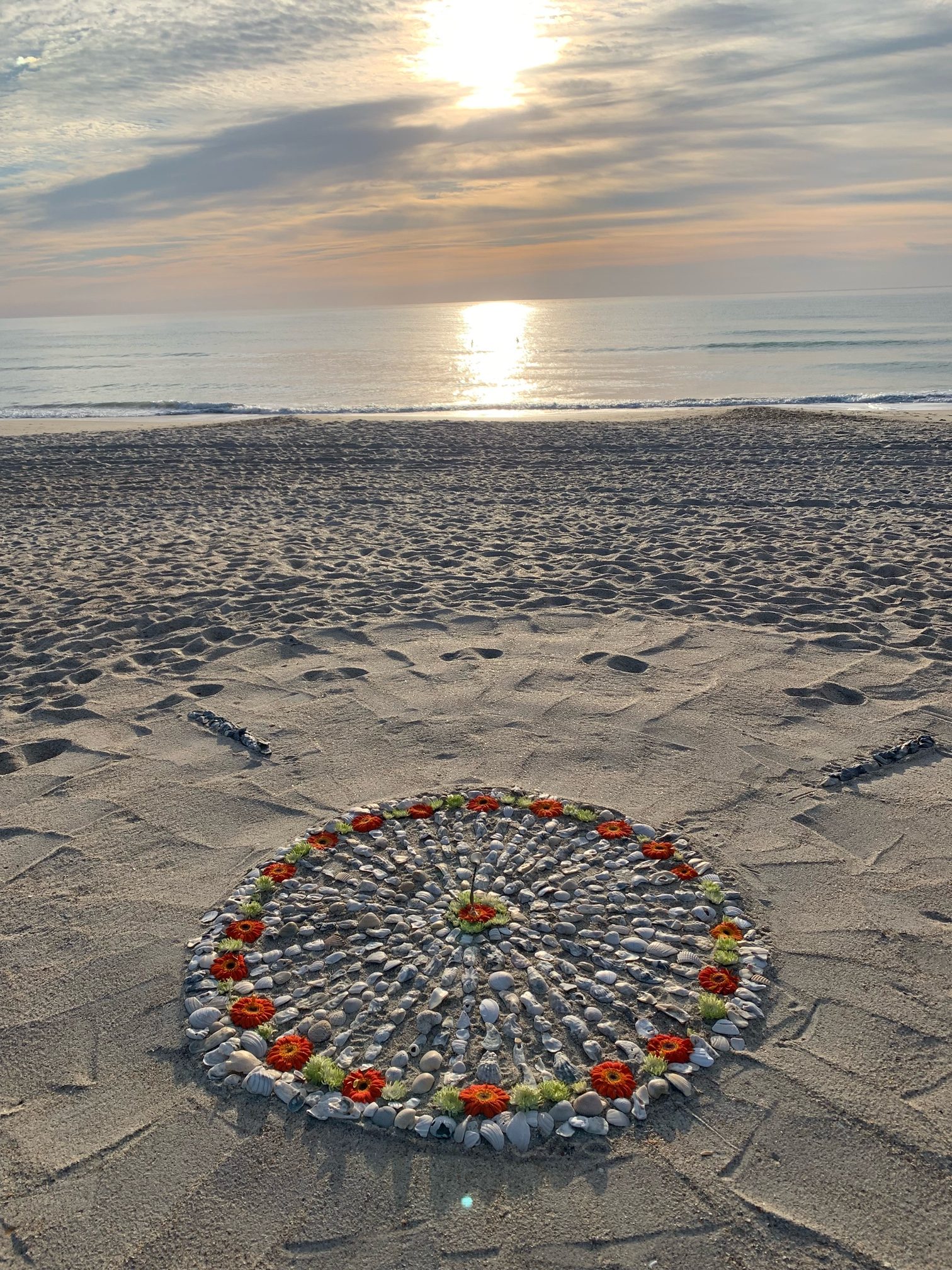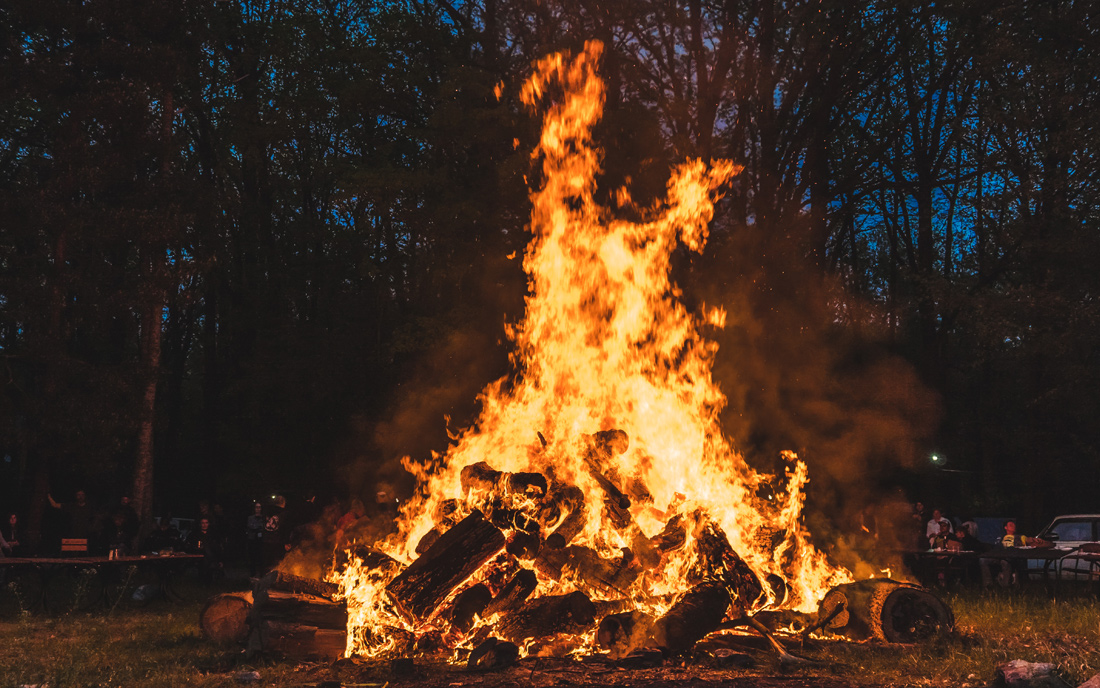The Practice of Lucid Dreaming
The Practice of Lucid Dreaming
When one goes to sleep, he takes along the material of this all-containing world, himself tears it apart, himself builds it up, and dreams by his own brightness, by his own light. Then this person becomes self-illuminated. There are no chariots, spans, roads. But he projects from himself chariots, spans, roads. There are no blisses there, no pleasures, no delights. But he projects from himself blisses, pleasures, delights. . . . For he is a creator.
– Brihadaranyaka Upanishad, 6th Century BCE.
The earliest religious texts among the people of the Indus River Valley, known as the Vedas, included a variety of practical measures to please the gods, including prayers, ethical precepts, and instructions for rituals and sacrifices. At some point after the Vedas, another kind of religious text emerged, the Upanishads, written by unknown figures over many centuries. Turning the focus of religious practice inward, the Upanishads presents a mystical philosophy of the self.
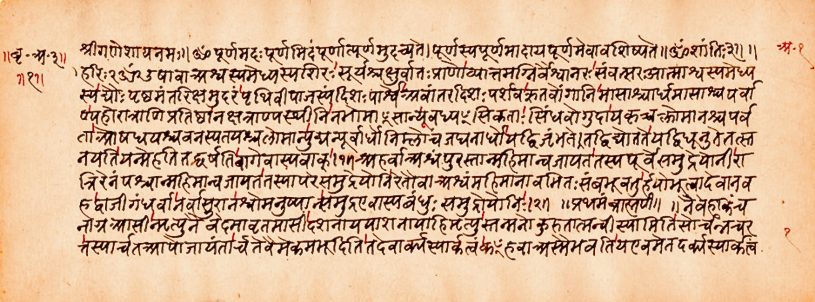
The spiritual insights in these texts can be profound, and, in the realm of dream research, highly relevant to our present-day concerns. The Brihadaranyaka Upanishad presents a model of dream formation that seems to rely on nothing other than the creative power of the dreamer’s own mind. No gods or demons are involved, no journeys of the soul, no mingling with spirit beings. All that appears in dreaming, according to this text, is projected from the dreamer, drawing on the energy of “his own brightness, his own light.” This might sound like a surprisingly modern theory, close to what we dream researchers today call the neurocognitive approach. And yet the Brihadaranyaka Upanishad places dreams within a bigger framework of the spiritual evolution of consciousness. The text describes four basic states of being: waking, dreaming, dreamless sleep, and turiya, which is a transcendent state of divine immersion and infinite consciousness. In this setting, the exploration of dreaming becomes a valuable source of spiritual growth.
This realization—that the inner light of your unconscious generates the worlds of your dreams—can become a stepping stone toward the higher realization that the divine light creates the world of your waking reality.
Just as God creates the universe, you create your dreams. To see more of that creative power in yourself is to see more of it in the world too.
In the contemporary study of dreams, the biggest of big fish for many researchers is consciousness—specifically the kind of consciousness that appears in lucid dreams. Maybe you have experienced dreams yourself, in which you were aware of being within a dream. Perhaps you have never had a dream like that, and you are curious why some people get so excited about the idea. For as long as I have been in the field, researchers have been arguing about the nature and significance of lucid dreaming.
We in the modern West did not “discover” lucid dreaming. As indicated by the opening quote from the Upanishads, people throughout history have been familiar with variations in self-awareness within dreaming. In later Buddhist traditions in India, China, and elsewhere, efforts were made to extend classic practices of meditation into sleep, with the resulting insight into the self-created nature of reality. Here is a passage from The Life of Milarepa, a sacred autobiography by a famous Tibetan Buddhist sage from the eleventh century CE:
During the day I had the sensation of being able to change my body at will and of levitating through space and performing miracles. At night in my dreams I could freely and without obstacles explore the entire universe from one end to the other. And, transforming myself into hundreds of different material and spiritual bodies, I visited all the Buddha realms and listened to the teachings there. Also, I could preach the Dharma to a multitude of beings. My body could be both in flames and spouting water. Having thus obtained inconceivably miraculous powers, I meditated joyfully and with heightened spirit.
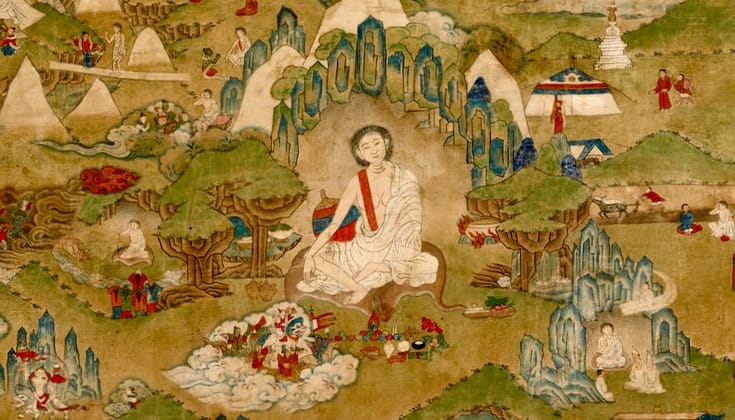
Rubin Museum of Art | Gift of Shelley and Donald Rubin
C2006.66.460 (HAR 921)
This sounds like a peak lucid dreaming experience. And yet, in the context of Milarepa’s life and spiritual development, it only marked a momentary stage in his further growth. Two points are crucial here: first, Milarepa’s incredible powers did not appear instantly but only after years of patient training and meditation practice. There is no fast and easy method for having these kinds of dreams. And second, Milarepa did not become attached to these powers, as if becoming a magician was the goal; rather, he let them fall by the wayside as he moved forward in his spiritual journey.
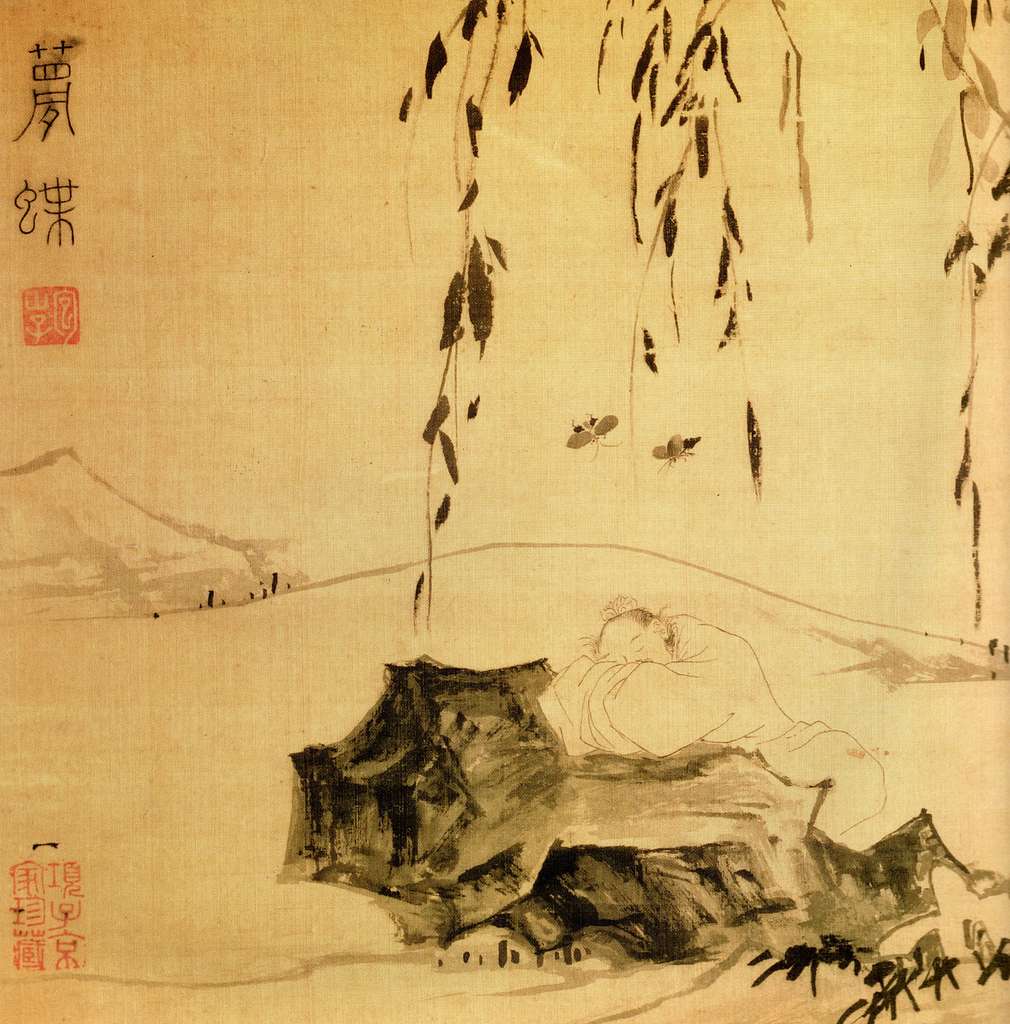
A similar insight comes in another classic work of Asian spirituality, The Inner Chapters by the Daoist sage Zhuang Zi in the third century CE. You may already be familiar with this text, in which Zhuang Zi shares an extremely vivid dream of being a butterfly, flying freely in the air. Then he suddenly wakes up and wonders if he’s a man who dreamed of being a butterfly or a butterfly who is now dreaming of being a man.
For Zhuang Zi and the Daoist tradition, his dream offers a memorably poetic expression of the higher truth of the transformation of all things. Within this lineage of spiritual wisdom and practice, gaining magical powers matters far less than learning to recognize the endless flow of consciousness as it shifts from one state to another.
Becoming a Lucid Dreamer
In developing dream recall, as with any other skill, progress is sometimes slow. Don’t be discouraged if you don’t succeed at first. Virtually everyone improves through practice. As soon as you recall your dreams at least once per night, you’re ready to try lucid dreaming.
Keeping a dream journal
Get a notebook or diary for writing down your dreams. The notebook should be attractive to you and exclusively dedicated for the purpose of recording dreams. Place it by your bedside to remind yourself of your intention to write down dreams. Record your dreams immediately after you awaken from them. You can either write out the entire dream upon awakening from it or take down brief notes to expand later.
Your dream journal is a tool, and you are the only person who is going to read it. Describe the way images and characters look and sound and smell, and don’t forget to describe the way you felt in the dream—emotional reactions are important clues in the dream world. Record anything unusual, the kinds of things that would never occur in waking life.
Dreamsigns: Doors to Lucidity
A strange little detail in your dream may help you to realize you are dreaming. I have named such characteristically dreamlike features “dreamsigns.” Almost every dream has dreamsigns, and it is likely that we all have our own personal ones.
Once you know how to look for them, dreamsigns can be like neon lights, flashing a message in the darkness: “This is a dream! This is a dream!” You can use your journal as a rich source of information on how your own dreams signal their dreamlike nature. By training yourself to recognize dreamsigns, you will enhance your ability to use this natural method of becoming lucid.
Autosuggestion Technique
Relax completely
While lying in bed, gently close your eyes and relax your head, neck, back, arms, and legs. Completely let go of all muscular and mental tension, and breathe slowly and restfully. Enjoy the feeling of relaxation and let go of your thoughts, worries, concerns, and plans. If you have just awakened from sleep, you are probably already sufficiently relaxed.
Tell yourself that you will have a lucid dream
While remaining deeply relaxed, suggest to yourself that you are going to have a lucid dream, either later the same night or on some other night in the near future. Avoid putting intentional effort into your suggestion. Instead, attempt to put yourself in the frame of mind of genuinely expecting that you will have a lucid dream tonight or sometime soon. Let yourself think expectantly about the lucid dream you are about to have. Look forward to it, but be willing to let it happen all in good time.
Excerpt from: Exploring The World Of Lucid Dreaming
A Step By Step Guide By Stephan Laberge
Internet Archive
Turiya is not that which is conscious of the inner (subjective) world,
nor that which is conscious of the outer (objective) world,
nor that which is conscious of both, nor that which is a mass of consciousness.
It is not simple consciousness nor is It unconsciousness.
It is unperceived, unrelated, incomprehensible, uninferable, unthinkable, and indescribable.
– Mandukya Upanishad
All composed things are like a dream, a phantom, a drop of dew, a flash of lightning.
That is how to meditate on them, That is how to observe them.
– The Diamond Sutra
Just as, O king, a dream is unreal, so is the universe. Who is it who constructs the universe? This is also unreal.
– The Questions of King Milinda (Milindapañha)
It is clear that all three major religious traditions of Asia—Hinduism, Buddhism, and Daoism—have been familiar for thousands of years with experiences of self-awareness in dreaming. More than that, all three of these traditions have developed practices aimed at cultivating these kinds of dream experiences and channeling their energies toward spiritual growth and enlightenment.
Much less attention to the conscious dimensions of dreaming appears in Western history. Although the ancient Greek philosopher Aristotle mentions in passing the occurrence of self-awareness in dreaming, he gives no special attention to it. The rise of the Abrahamic traditions of Judaism, Christianity, and Islam put more emphasis on the content of dreams as messages of divine reassurance and prophetic warning. But they bracketed out the questions Zhuang Zi and other Asian mystics were asking about the form of dreaming as a state of consciousness.
Eventually, in modern Western society, it no longer became possible, as a matter of linguistic usage and common sense, even to speak about self-awareness in dreaming. Talking about being aware in a dream was like talking about the coolness of fire or the softness of a rock: you were making no sense. People could talk about lucid dreams in the context of occult and esoteric writings, but these reports were often meandering and impressionistic, making it easy for mainstream scientists to dismiss them out of hand.
Making broad generalizations about something as complex and multifaceted as human religiosity is difficult. Yet the historical evidence suggests a real difference of attitude toward lucid dreaming between the Asian religious traditions of Hinduism, Buddhism, and Daoism, on the one hand, and the Abrahamic traditions of Judaism, Christianity, and Islam, on the other.
The former group, by and large, acknowledges the varieties of consciousness in dreams and sees this as a spiritual opportunity. The latter group, by and large, ignores consciousness in dreaming and regards it as spiritually irrelevant. Most Indigenous cultures, especially those with shamanic practices, would seem to side with the Asian religious traditions on this issue.
Neither perspective is ‘right or wrong’. If nothing else, this brief history suggests that the current excitement about lucid dreaming in the modern West might represent a kind of cultural rebound effect. Perhaps many of us are experiencing a new surge of interest in lucid dreaming because our culture has paid such minimal attention to this aspect of our dreaming selves for centuries.
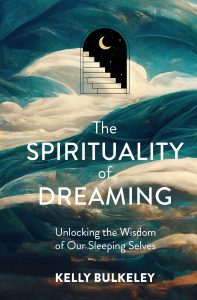
Excerpted with kind permission.
The Spirituality of Dreaming: Unlocking the Wisdom of Our Sleeping Selves by Kelly Bulkeley
Available now: Amazon, Barnes & Noble, Bookshop.org, Broadleaf Books
Return to Ageless Spirit Contents Page
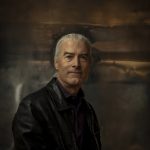
About Kelly Bulkeley, PhD
Kelly Bulkeley, PhD, is a global expert on dreaming and a psychologist of religion focusing
on dreams. With degrees from Stanford University, Harvard Divinity School, and the
University of Chicago Divinity School, he is director of the Sleep and Dream Database,
senior editor of the journal Dreaming, and former president of the International Association
for the Study of Dreams. His books include Dreaming Beyond Death, Big Dreams, An
Introduction to the Psychology of Dreaming, and Dreaming in the World’s Religions. His work
has published in the New York Times and TIME magazine. Bulkeley lives in Estacada,
Oregon.
The Power of the Immersive Arts to Catalyze a More Peaceful World
Featured photo | Immersive Art Show: ‘WERK in Progress’ | CC BY-SA 4.0 DEED
“For millennia, gathering around fire has been inspiring conversations that evoke the imagination, help people remember and understand others in their social networks, heal rifts of the day, and convey information about ways of being that generate productive behavior and relational trust.” -Polly Wiessner, Anthropologist
For those of us who strive to remain grounded, awake, sensitive, and conscious of what’s going on in the world today, it’s clear that we are living in a defining epoch of earth’s story, and of the story of humanity itself. We are witnessing precipitously rising levels of ecological degradation, species extinction, violent conflict, authoritarianism, and economic disparity.
In my journey as a lifelong musician, and as a social artist committed to crafting transformative experiences, I have aimed to bridge divides, heal wounds, realign spirits, inspire souls, and unify the fragmented aspects both within us and in the world around us. This dedication has convinced me that there is an evolving, more engaged role that the arts must serve in our society if we want to leave a world where our children might not only live, but truly flourish.
The Immersive Arts | Catalysts for Coherence
What exactly are the immersive arts?
Immersive art forms have the power to deeply resonate and transform people. They intentionally combine experiential elements such as music, spoken word, and poignant imagery to catalyze proactive changes in our emotional, somatic, and spiritual states. When the need for compassion and tolerance is more important than ever before, it’s vital that we explore new ways to tap into these arts strategies. They can subtly influence us to evolve into more holistic individuals, fostering open-heartedness, receptivity, and presence. As the world’s complexities mount, these forms of expression become essential bridges, guiding us towards more humane interactions and understanding.
For the last twenty-five years, I have devoted myself to creating immersive music, transformative and healing media, and musically enhanced art forms for health and well-being. My aim has been to inspire individuals to navigate both their professional and personal journeys with heightened mindfulness, resilience, compassion, and gratitude for the preciousness of life.
By integrating immersive arts modalities in a certain way, and at a certain time, I discovered they could help counteract the insidious numbness of social disengagement, potentially even rekindling an inner vibrancy. My hope is that this offering might embolden you to discover your own versions of the principles I share here, taking the time to notice what happens within you when you engage with immersive art forms.
What started me on this journey? I began playing the piano at five years old, when I could basically play any tune I heard. My formal education led me to institutions like Oberlin Conservatory where I focused on composition and ethnomusicology, (which was an early clue about my fascination with immersive art forms). After years of yearning to be a film composer, I mastered the art of film scoring —the craft of creating music that subconsciously resonates emotionally with the viewer, enhancing narratives and evoking emotions. By the early 1980’s, I had founded one of the most successful music production companies in the San Francisco Bay Area, and I spent the next eighteen years scoring national television shows, feature films, and commercials.
However, in 1998, after nearly two decades of success, a serious bicycle accident left me wondering if I would ever play the piano again. Not long after, I experienced a heartbreaking separation from my wife, with whom I was blessed to have a daughter. Having recently lost my father, the series of profound losses forced me to reevaluate my identity and purpose.
As luck would have it, I was approached at this time by pioneering healing team Michael and Doris Stillwater to explore how we might musically support those facing death, dying, and the end of life process. I ended up pouring my soul into the creation of some of the most powerful music that ever came through me. The project, entitled Graceful Passages: A Companion for Living and Dying, resulted in a globally acclaimed listening resource that carefully edited, curated, and musically enhanced the spoken messages of solace and support from world-class visionaries such as spiritual teacher, Ram Das, death and dying pioneer, Elisabeth Kubler Ross, renowned Buddhist teacher, Thich Nath Hanh, and nationally known Rabbi Zalman Shacter- Shelomi, to name a few.
As Graceful Passages became known more around the world, I dedicated myself to exploring more ways in which music and sound modalities could meaningfully impact the psychosocial healing process for patients, professional caregivers, family members and even our social networks and institutions, especially during the most significant passages we will ever traverse: birth, serious illness, and the dying process.
I wondered, can we harness these art forms to awaken multi-dimensional coherence on a personal and collective scale? How could these art forms play a role in fostering more peaceful and collaborative ways of engaging with each other, or even with ourselves during the most significant transitions of our lives?
Transformances | Awakening the Art of Interconnectedness
Over 400,000 years ago, humanity embraced the elemental power of fire in tribal rituals, awakening a primordial connection with themselves, the planet and one another. Beyond its practical uses, it was a communal touchstone, bonding people through shared rituals and gatherings, reflecting our connection with the cosmos.
In today’s digital age, many of us crave that deep-rooted connection. Yet, through immersive art modalities, we can harness online platforms to foster these primordial bonds around zoom’s digital “fires”. When we become more emboldened to engage in more heart-centered practices in professional contexts (supported by the science, of course) we can elevate our community gatherings into more unitive and memorable experiences. This approach embodies the principles of Emanuel Kuntzelman’s seminal compilation of essays entitled “The Holomovement”, which urges us to recognize the unity of all things, inviting us to actively participate in our culture’s transformative shift from the ‘ME’ of individualism to the “WE” of a global community ethos.
In a quest to spark this sense of global unity, I collaborated with author and visionary Sarah McCrum to produce a series of short, contemplative films that I entitled “transformances.” These short, evocative pieces were commissioned by Unity Earth executive director, Ben Bowler to provide the 2022 World Unity Week with transcendent shared experiences for the global online program. They served as immersive catalysts, inspiring thousands of people from around the world into a shared collective introspection. I share with you this one – Invitation to Unity, – which we extemporaneously created to share at the beginning of meetings, as an instrument for deeper, more connected and collaborative social interactions. Many of us observed that the effect was immediate; hearts opened, boundaries dissolved, and people breathed more deeply, fostering a collective environment of unity, connection and understanding.
In our age of divisive media and dwindling attentions, these art forms offer a rare refuge. They provide moments to pause, allowing participants to rest their cognitive minds while grounding themselves in gratitude and connection. It aligns us with the intrinsic interconnectedness that indigenous wisdom and modern science both recognize.
Imagine major institutions adopting such modalities—starting business meetings with two minutes of beauty and insight, cultivating an atmosphere of collective intent. When organizational leaders adopt such immersive formats, they champion collective well-being, for the good of the whole. Such artistic pauses have the potential to shift outcomes, broaden horizons, and reconnect us with our shared human legacy.
The Power of Vibration and Frequency
In the vast celestial dance that binds the universe, everything vibrates – from the palpitations of our hearts to the oscillations of distant galaxies. As our societies struggle through storms of change and uncertainty, an understanding of frequencies and vibration becomes imperative.
When we transcend entertainment, music can serve as a vibration-based vessel, navigating our way to ignite empathy, bridging cultural divides in shared communal experiences, and elevating our ability to become more centered in our hearts. And when we utilize music to help people connect the sacred stillness within themselves – in these times of over-stimulation, violence, and heart/mind fragmentation – we are given the chance to come back home to ourselves, to our sense of belonging.
Merely relying on intellect to address global challenges is a misstep. Real change emerges when the mind’s brilliance aligns with the heart, where the arts come alive acting as bridges, transcending cultural barriers, promoting compassion, and highlighting our shared humanity. In our fast-paced world, intentional pauses are vital. By aligning with the beautiful frequencies of nature, we can elevate individuals and communities, fostering holistic engagement and deeper connections.
Visualize city councils invoking shared purpose through multi-sensory experiences, or corporate boardrooms reconnecting to humanity before making decisions. Envision classrooms worldwide beginning with videos that foster mindful collaboration and curiosity. This is the immersive arts’ magic: recalibrating our collective intentions and awakening to what matters most for our collective well-being.
Now is the moment to integrate these immersive arts strategies to craft experiences that know no borders. Let’s start inviting artists who are dedicating themselves to applying these modalities towards the Greater Good to wield their transformative power, celebrating our interconnected essence. Together, we are called to resonate, align, and architect a harmonious future with a more courageous intention to allow these compelling experiences of coherence and beauty to have its way with us – aligning our life-generative intentions, awakening our interconnectedness, and catalyzing a felt sense of our unity with all life.

About Gary Malkin
Gary Malkin is a multiple Emmy award-winning composer, producer, public speaker, music & wellness consultant dedicated to harnessing music’s capacity to cultivate multi-dimensional coherence, especially during the most challenging transitions and phases of our lives. The composer/producer of the globally-acclaimed listening resource, Graceful Passages, (co-created with Michael and Doris Stillwater), creator of the successful Gaia streaming TV series, Islands of Inner Peace, & the co-creator of the widely respected caregiver audio series, Care for the Journey, Gary has just completed a fully realized stage musical about the miracle of birth and life with his collaborators, Lisa Rafel, and corporate leadership consultant, David Surrenda, Ph.D. called “Can You Hear Me? A story about sex, love and OMG Birth”. (www.CanYouHearMeTheMusical.com) Gary is a frequent guest on webinars where he introduces innovations in health, wellness, and personal/spiritual development. He is currently launching a new educational platform with spiritual guide, Hope Fitzgerald designed to help people cultivate resilience and grief literacy while mastering the art of change called You, Awake. (www.You-Awake.com) He collaborates with author/visionary, Sarah McCrum, on the creation of ‘transformances”, extemporaneously created immersive media resources for catalyzing coherence, holistic attention, and presence. A member of the Association for Transformational Leaders & The Evolutionary Leaders in good standing, Gary is committed to innovative ways in which deep listening to immersive arts resources can awaken higher states of unity consciousness. His websites are www.WisdomoftheWorld.com and www.You-Awake.com.
The River Threshold
The River Threshold
THE ENDING CAME three years ago, from the day before we went to the river. One version of the ending, anyway. She and I sat at a picnic table near a stream with a therapist who was also my uncle, and we said out loud in the summer June air that we couldn’t give what the other wanted. She said she couldn’t live with me anymore and be who she wanted to be. I said I couldn’t live indefinitely separate and fragmented. We said these things for the purpose of freeing each other, though freedom didn’t liberate like we thought. There have been numerous endings. Another ending came down by the river, three years and a day later.
I’ve come to learn that transitions don’t often look like crossing a straight line. We circle back, or in some way forward, because circling is rarely a straightforward repetition of what came before. Instead, it’s a need to follow-up, continue, revolve. Grief is the emotion and the practice that accompanies irreversible transition – like final goodbyes, certainly all kinds of death, even births because all beginnings start with an ending.
Grief never completely goes away either, circling like water cycles, tears turned to thunderstorms, so pieces left from these endings didn’t get cleaned up, growing back together again in a hurtful dark. John O’Donohue, poet-priest from Ireland, pictured this process like being “ambushed” in the middle of daily tasks, when you think you finally have your heart back. Ambushes, small and large, kept surprising me, so I knew I needed to transition again, or make visible a practice of my transition. I felt ready to cross the threshold into the next time of my life, to leave behind an architecture I no longer lived in but perhaps occasionally squatted in, a memory palace where particular dreams still had a haunting life. As far as I was concerned, those dreams were welcome to remain encamped there, but I needed to move out.
Another poet, David Whyte, once remarked that the greater difficulty of a relationship’s end may not be leaving the person but leaving the shared dreams. No matter who or what comes next, he said, “no matter what species of happiness you would share with them – you will never, ever share those particular dreams again, with that particular tonality and coloration.” The end is an extinction.
But I was ready, really actually ready, for a new lease on a house of life. Life was moving on, as it always does, and I was mostly living it, though parts of me weren’t. I needed help to step through the doorway from this dying house. So two friends came to help me cross the threshold.
***
DAVE AND KYLE have been involved in all this from the beginning, from building that house, talking about its construction, to sitting in its loneliness with me, now helping me move out. Kyle and his wife Ginger even officiated the wedding, the ceremonial moving in, talking in the thick damp Arkansas heat about marriage as coevolution, which confirms the end is indeed an extinction. Kyle also first offered me the language of architecture for understanding the close intimacy, the careful maintenance, of inhabiting a marriage, and the many painful ways its borders can be violated. Dave was at the wedding too, reading Wendell Berry’s “The Country of Marriage,” a long poem about marriage as a place to adapt to, where general affection becomes particular love and an unfamiliar landscape becomes home. Country is a distinct metaphor from architecture, though similar enough that selectively re-reading the poem now eerily surveys a different country. Or perhaps the same one, now seen with grief after exile, anguish after extinction.
Instead of moonlit longing and restful union, consider insomniac nightmares held captive by the one you love: “I dream of you walking at night along the streams . . . You are holding in your body the dark seed of my sleep.”
Or the dizzying unknowing of why we were drawn together at all, times when no words came, ambushed instead with unexpected visions:
Was it something I said
that bound me to you, some mere promise
or, worse, the fear of loneliness and death?
A man lost in the woods in the dark, I stood
still and said nothing. And then there rose in me,
. . . the words of a dream of you
I did not know I had dreamed . . .
And then, with a twist of finality, twisted from the abundant freedom of self-release into the suffocating abandonment of drowning:
What I am learning to give you is my death
to set you free of me, and me from myself
into the dark and the new light. Like the water
of a deep stream, love is always too much.
Grief can do that to you, make you question everything you thought you knew or understand, like poems or people. Did I hallucinate all that tenderness? Those times that felt easy and comfortable? Did I make that whole country up?
Dave has crossed through this country in his own life. I’ve sometimes been jealous of his journey because he was much less responsible for its ending than I am for mine. But I no longer want to linger on the sharp fault line edges of my flaws, though the voices in my head, sometimes spoken in her tone, remind me of who I’ve been when I tried to defy my failings. It always takes at least two, but could I even be good, the voices asked, when I’m so imperfect? Doesn’t imperfection mean I deserve what I got? “Flickers of guilt kindle regret/For all that was left unsaid or undone,” wrote John O’Donohue about the heat I’ve felt. Guilt is a real condition, regret a necessary emotion, but I no longer hate myself and I want to keep it that way.
My friends came for a June weekend and we talked, hiked, looked at my gardens and the nursery where another friend and I grow trees and ourselves. That first night, successively drinking whiskey, bourbon, and gin, I told them that I couldn’t shake the image of threshold, its old word-roots grown from a double sense of treading and separating, walking and winnowing. Crossing over something into somewhere else, returning changed to a changed place. In her manual on power, Cyndi Suarez reminds that rites of passage always “begin with a threshold – a challenge one cannot meet without transcending one’s current idea of oneself”: a strategy for meeting needs no longer works, a story no longer rings true, an initiatory move into a new age. That transcendence was what I was looking for. The earth also has thresholds, from one biome to the next or when slow small disturbances finally crest into quick changes. That’s where I was, at the biome doorway. I needed to physically walk through a threshold, to separate myself from the past by treading, not just talking about it.
They listened, asked questions. Dave wondered if there was anything else I needed to say to her. I knew there was, especially towards the very end, but I’d never really let myself speak directly to her those words out of fear of making it worse, out of fear of sounding like I was avoiding myself. I spoke countless things to her in our short shared life: some beautiful, some vulnerable, some cynical, some that still taste bitter in the mouth. After too much time defending and deflecting, the bitterness baked into a story solely filled with all my dysfunctions and imbalances. Usually all I could see were those sharp fault lines, all my worst moments carved in stone. Dave told me that a grief ritualist suggested to him that he say his unsaid words out loud, as if to his former partner but directed to a rock. Your soul, the ritualist explained, doesn’t know the difference between the firmness of the rock and the firmness of her. Your soul simply needs to speak. Maybe, Dave added, I also needed to say out loud a counter-narrative to the bitter stone story.
I told them I wanted to be by the river. I’d spent a lot of time there, crying my grief into the flow, ritualizing my return to this chosen home, joyful play with friends floating in the current. The river felt right. Partly because I think emotions move like water, and grief is like their river. My friend Karla McLaren, loving guide to emotions and empathy, says that grief is unlike sadness, which arises to help us let go of what’s no longer working but we could choose to hold onto. Grief arises when something is actually lost, a never-to-return loss, taking us down to the deep places because they are the only places left to go. Grief moves at extinction events, when things die. I decided to take grief to the South Fork of the Shenandoah, to the river I know.
Before Kyle and Dave came, my grief had already moved me to the river, stepping in, lifting my feet, floating further down. I swam over to a shelf of rock cropped out from the steep bank beneath the road. I undressed, reentered naked, with my grief, to midriver where the current swept swiftly. I bore my feet down into the stone and used an old drifting mop handle to anchor myself. I didn’t know what I was going to say, with so little to draw on in my so-called culture, this whitewashed colonizing culture, death-denying and therefore grief-avoidant. Martín Prechtel says that it “is a terrible source of grief in itself to not be able to grieve.” So I made up what I needed to say on the spot. “So be it,” wrote Cormac McCarthy in The Road. “Evoke the forms. Where you’ve nothing else construct ceremonies out of the air and breathe upon them.” I constructed a ceremony out in the otherworld of water and I screamed it under the thudding slip of the current.
Unable to grieve, we’re haunted by what we’ve lost, trapped in-between, never separated enough from the loss to tread to another union. Grief can’t be outrun, outthought, though it can be outsourced, pushing the burden to someone and somewhere else with unforeseen consequences, grieving turned to grievance. Grief is a powerful enough riverine force that it needs ritual, instinctive or inherited, to help responsibly shape its course, charting the changes that always shape our lives. Francis Weller identifies two gifts ritual offers grief: containment and release, the safe holding and the free letting go, a kind of vessel for pouring. Ritual doesn’t erase wounds, doesn’t forever remove the burden of grief, but it maintains and tends, helps us offer gratitude where we can, provides regularity for the maintenance and tending. Repeating a ritual doesn’t mean anything is broken. Maybe my grief wasn’t stuck, just unfinished, maybe never quite done, the ritual never completely over. My desire for a threshold was a need to find my ground, to create an altar or shape, like the river itself. An actual river to correspond to what Weller names “riverbeds in our soul” carved by sorrow.
Maybe, I told Kyle and Dave, we could make a threshold on the ground with sticks or stones like my fault lines, dismantling them once I crossed to recognize the movement. But the image still looked too much like crossing a straight line, even though taking it apart afterwards disrupted the linearity. Whatever the threshold, it needed to be actual, made with the world itself. Dave encouraged me to write down what I needed to say, then burn it. Then Kyle said maybe the river is the threshold. We should cross it and on the far shore make a fire and burn the words there and then cross back over. The flame and the flowing moving place were to be the doorway in time, a grounded sense of time, which moves in cycles and not lines. I said that’s what we needed to do.
***
Moving in circles, I had carried grief to the river before and yelled an underwater ceremony. I had also burned words before, a disposal to signify an end. Nothing broken, only maintenance and tending, moving in circles. Six months after the picnic table ending, I moved out of the Shenandoah Valley to be near family, to separate and heal, maybe to run away. In the ensuing weeks I couldn’t sleep for feverish turning, fitful weeping for her. For months prior I carried a stack of printed emails, ostensibly to provide a thorough history for therapists, but also somehow evidence of chaos-making communication, a paper trail to defend myself.
One late night I evoked the form of a ritual. I typed her a new email, this time in a different tone than before, no more ands or buts or also, simply “Yes, I am sorry.” No excuses or defenses, just responsibility for my part without expectation and a list of all the gifts she’s given me. I told her I felt more broken open than ever before, remembering all the instances when I was demanding, stubborn, condescending, overly assertive in my presence and desires, the ways she then backed away, lay low, withdrew in response. I told her I felt sick at my immaturity and misunderstandings that led to arguments, silences, turnings away. I could taste the dismissing tones in my mouth, could hear their off-key pitch, could feel their imprint in the squint of my face. I told her I was sorry. I apologized because I needed to so I could be who I wanted to be. Because apology is a kind of naming. Because sometimes we do wrong things, and it’s important to admit them. Then I shaved my beard, cropped my hair close, stripped, and made a fire in the yard. I burned the hair and I burned the paper trail so I couldn’t follow it again. The ritual did something only it can do, what talk therapy can’t get at. After sending her the email and burning the papers I slept more soundly than I had in recent memory. I also still had my grief when I woke up.
At some point, a time between the burning in the yard and the burning by the river with my friends, after many more things had been said, she also wanted a ritual to end our marriage. She told me she wanted to break the wine glasses I gave her for our first anniversary, at the homestead where our marriage lived and struggled the longest. After a week of trying to convince myself to do it, I replied no, thank you. I understood, even respected, the intention, but the tone and the act felt nearly violent in the midst of unrequited words, unreciprocated responsibility, and premature for what I actually wanted at the time but felt was no longer possible: to repair all this shit, to resurrect extinct dreams, to be with her light and warmth.
***
I feel some awkwardness writing all this down now, a little embarrassed at the melodrama of it. Perhaps that’s true of intimate moments of transformation told aloud. I’m tempted to temper the personal focus, abstracting my experience into a general meditation on marriage or the grief of this time, from viruses to civil war vibes. But that’s not what this story is about. I’m attempting to write vulnerably, a version of truthfully, without self-pity but with detail to the ritual of grieving heartbreak and mistake. I don’t want to distract from that with generalities or dilute it by drawing attention to all the ways I was hurt too. Each ritualized time felt ordinary, almost exactly natural, an invitation to feel deeply without selfishness. Weller believes that sorrow connects us to the world, the personal to the planetary, and all this personal talk of endings does make me think of the planetary ones. He says that grief finds us through five gates: the reality that we lose everything we love; the places that haven’t known love; the loves we expected but never received; the sorrows of the world globally known but individually felt; the unmetabolized grief inherited from our ancestors. Gates are, after all, thresholds, and all of Weller’s gates involve separation and treading. They all weave together the solitary and the social, the personal and the pandemic.
As for embarrassment, Prechtel affirms that this is grief’s natural and necessary sound, indifferent to misunderstanding. Purposely done, he believes, true and free grieving as an entire people could revive entire cultures, it could “make life more deliciously alive.” And Grief is in fact the best friend of Praise, dwellers in separate chambers of the house of Love, which is the heart. “Grief is praise,” Prechtel vows, “because it is the natural way love honors what it misses.” Both “are very practical versions of love in motion,” a river not a bog.
We can never praise if we never grieve.
***
WE DROVE DOWN out of town to the river, in the gray spray of rain. Parking roadside, we descended a footpath to the wide floodway, filled with trees along a tributary creek. The green of the place met my vision and focused me down under the canopy to the cool wet air and earth. Dizziness clouded me in recent weeks, unable to steady my gaze, as if I were looking through a screen or the long lens of a telescope. But the green and gray, the silvered brown of the river, brought me to attention.
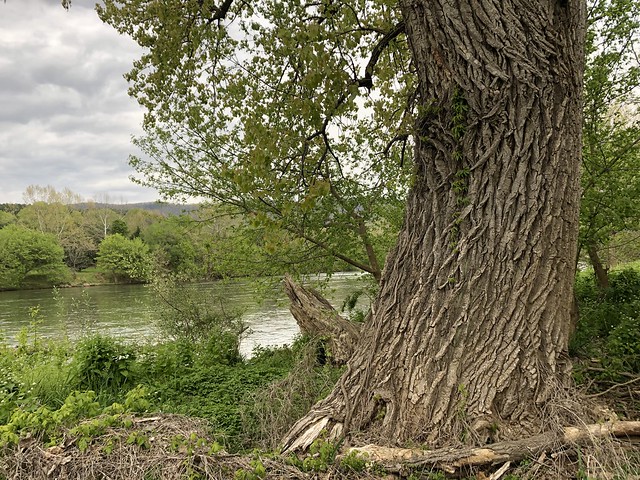
We treaded the soft last path to the bank, colonnaded by rows of Sycamore and Cottonwood, some of the tallest and roundest of either tree I’ve seen in this great valley. Every time I walk that path I stop short before them, each time struck by the size of their immense gorgeous growth. Tree size isn’t a good gauge for age, and both Sycamore and Cottonwood grow very quickly, but those trees have certainly been there a while. Some of the trunks would take all three of us to wrap our arms around. On this day, Sycamore and Cottonwood appeared out of the gray like gatekeepers, druidic in their rooted silence, calm in the lengthening rings of their lives that regard as restless my sense of patient time. Prechtel says grief “is what living beings experience when what or whom they love dies or disappears.” Living beings: more-than-human, more-than-mammals, more-than-creatures-with-brains. I wondered what loves those trees have seen disappear, and what arboreal grief sounds like. I touched the living barked beings closest to the path as we passed, toward a ritualized past.
I felt my stomach coil as we came out of the trees to the water, heard before seen. Not a resistance to what we were doing, but a hesitance. I had symbolized my grief here before to make this place home, but the invitation for grief to come in the company of these friends, to cross a threshold at and as this river, moved down in my body with appropriate gravity. What moved in my gut also seemed to move through the land, circulating through me and the water and wind, then grounding itself in the imagery of a house, with a doorway I needed to cross to make a new home, one I was already preparing for and should step into, resolvedly, committedly, readily. I was now in a relationship with a wonderful person, Christen, and we had been dreaming about that new home, both relational and physical. But I hadn’t been fully ready to plan, with dates and announcements and communal ceremonies to witness the commitment made, which was another threshold I would need to cross. First, I needed to step over this one, to separate and tread, winnow and walk, in a communal ceremony with my friends.
I looked at the river and questioned if we should cross. The current’s clip was swift. Not dangerously so, but enough that we needed to move carefully and alertly. Dave found a soda bottle with a twist-on cap and shoved into it a lighter, a pen, and some paper. We stripped to our boxers and I descended into the cool water, kept a foot on rock until I was part of the way over before shoving off and plunging at an angle for the river to sweep me across. A thick stand of young Sycamores greeted me on the stony sandbar, with river’s fast flow behind me and slow pools ahead before the actual bank. Dave and Kyle followed and we crossed the shallow divide beyond the Sycamores and came to the far shore. For our purposes, we came into the otherworld.
The gray rain gave the world the pallor of ash. Lament was in the air, rain falling steadily like a kind of sadness. John O’Donohue heard in water the “voice of grief.” In one praise poem, he hailed the “grace of water,” its “liquid root” working through “the long night of clay,” and also the “humility of water,/Always willing to take the shape/Of whatever otherness holds it.” The water from the sky shivered into the water through the land, expressions of a cycle turning over and over into one another. They met, flowed with persistence, a quiet but firm insistence that this day is what we had to work with, the water and the grief will not be unbearable, but they’re also not going away. So we made our ceremony with what we had, and I tried to imitate the humility of water by taking the shape of its own liquid root.
I separated from the shore and ducked further inland, just enough to where I had some solitude. I found what seemed like a path, another shape humbled by the flow of water. I knelt, opened the mason jar in my hand that held some torn pieces of envelope and biochar, wood from the stream in town cooked down into carbon to absorb nutrients. I carry the jar in my backpack, my homemade version of incense or anointing oil. When I remember, I leave a sprinkle at the feet of plants where I harvest food or gather seeds, or at the landfill when I contribute to its leaching burden. Biochar takes what is often discarded and turns it into a sponge to hold fertility, which is a kind of memory releasing over time.
I enclosed myself in a circle of char, smeared the stain on my fingers onto my forehead. Then I wrote. The rain quickly dampened the paper, but it took the words I needed to say. I wrote to her as if I spoke to her. I said the words that still stung me, the stories still hounding me, the regrets still hanging over me. But the only water that fell was the rain. I felt the heaviness of grief’s gravity pulling at my face, but my tears remained up.
When I finished writing, I slowly walked toward the bank. I smelled smoke, then saw clouded curls of it. Despite the damp, my friends had made a fire beneath a Sycamore and a Walnut. Between the two trees, past floods had packed bark, leaf, and twig into a dam from which Dave pulled enough dry material to ignite with the lighter. More sticks and small branches fed the smoky flame, the smoke becoming part of the overhead gray. We began placing rocks around the fire’s edge and huddled close to feed and feel its small warmth. I bent over my knees, elbows tucked down, face close to wet earth, holding wet paper that held the marks of my grief-wet words.
I read them aloud, parting the rain with their clearness, and my tears broke through to fall with the rain. My body had been holding more grief, a flow in need of moving before I had enough room for my life. I could have forced my way forward with it stuck, but I’d done that before, trying to be ready to move on when I wasn’t prepared, and I knew eventually grief would flood me again. The ritual made room, both to feel and for the feeling to pass on and make room for something else to move in. “It becomes hard to trust yourself,” wrote the again-wise O’Donohue.
All you can depend on now is that
Sorrow will remain faithful to itself.
More than you, it knows its way
And will find the right time
To pull and pull the rope of grief
Until that coiled hill of tears
Has reduced to its last drop.
My tears kept falling, uncoiling themselves as I spoke words I’d wanted to say to her but never fully said, now without concern for consequences. No attacks, no excuses, only honest and unhedged, stitching two stories out of the fault lines. Kyle and Dave didn’t react, saying nothing, maybe listening, watching the fire and offering company.
I finished what I had to say and crumpled up the sorrowed paper. I tossed it into the fire and despite the damp it too caught the light. I breathed audibly, a gasp of relief as those words turned red, then white into ash, then were gone. Dave gently stacked more of the river-racked tinder from between the two trees, our huddled shapes under them converting them into altars.
 I heard the river rumbling, somersaulting in currents down toward the sea. Everything around us – the leaves, the rain, the airy nutrients – gravitated downhill with the river, including our tears, including my grief, anything with the slight weight of loss. O’Donohue calls this the “courage of a river” continuing to believe in the gradual descent of ground. I had no more words of my own, so I sang a song to match the plumb line of that courageous direction, my voice cracking from the strain of being honest. Dave knew the low rolling tune so he sang too, and Kyle hummed until we sang through the cycle again.
I heard the river rumbling, somersaulting in currents down toward the sea. Everything around us – the leaves, the rain, the airy nutrients – gravitated downhill with the river, including our tears, including my grief, anything with the slight weight of loss. O’Donohue calls this the “courage of a river” continuing to believe in the gradual descent of ground. I had no more words of my own, so I sang a song to match the plumb line of that courageous direction, my voice cracking from the strain of being honest. Dave knew the low rolling tune so he sang too, and Kyle hummed until we sang through the cycle again.
We sat a few minutes longer, wind shushing through us, until I said I was ready. The fire died enough that I could scoop some white ash into the jar of black char, a symbol of dark carbon absorbing the nutrition. We spread the stone circle back out and let the rain dowse the embers. I picked up a small smooth stone, warm to the touch, about the same size as one I plucked from the shelf in my apartment at the last minute before driving to the river. The one she gave me after the last time she left, with a note telling me she was giving me this small stone, “a little guy” that she’d put a lot of love into.
I didn’t want to let it go. I wanted to keep holding it with a special place on my shelf-top altar. I could have done so and doing so wouldn’t be wrong except I knew it was no longer right for me. The small stone was just large enough to block the threshold into the next room, the room made by walking and moving the grief and that one small stone with love in it.
Kyle and Dave crossed the river first, fumbling in the rapids with goofy grins and laughter. I waited in the otherworld, crouched on the rock-rolled shore beneath the Sycamore stand until they crossed. Then I waded into the same river where I had shouted my grief the summer before. I swam to midriver, slipped underwater to the underworld, braced myself against the turning current. I opened the jar and poured the ash and char into the pastel river, bending up by the mountain but carried down to the sea. I came up out of the river and across the threshold.
I later learned that Karla McLaren suggests five rules for a good ritual. First, be clear about your intentions, to know why you’re having the ritual in the first place. Second, mark a clear beginning, with a phrase or sound or movement, so you know what came before and what comes after. Three, define the location of your ritual, with clear boundaries to know where the edges are in time and place. Four, feed and tend your altar or shrine, to stay alert and aware for as long as the ritual lasts. And five, close the ritual with intention, with a phrase or sound or movement, clean up what needs cleaning, remove what needs removing, and celebrate because good work has been done.
The three of us sat on the trunk of a branch, worn smooth by water. I retrieved a pipe from our bundle of shirts in a stump, along with a jar of dried Mullein leaves. We lit a small fire in the bowl, passed it between us, puffing herbal smoke into the smoky rain. We didn’t talk, just smoked, a quiet sober celebration at the ritual’s end. Dave and Kyle grabbed their clothes and I stood at the water’s edge, small love-filled stone in hand. I let it go in an arc to midriver where it crossed the surface line of the water, following the liquid root down, a disposal to signify an end. A story in firm stone to heal a fault line. Maybe my grief wasn’t stuck, only unfinished. Maybe never quite done.
We passed along the soft path back up the creek, beneath the cathedral Cottonwoods and Sycamores. Kyle hugged us, got in the car back to Connecticut. Dave and I drove up out of the river’s floodplain and back into the heights of town.
***
ALMOST FOUR MONTHS later, Kyle and Dave came back to the watershed, only a score of miles upstream from our river threshold, for my wedding ceremony. The two of us, Christen and I, decided a few weeks after the ritual that we were ready to move into the next room, the biome beyond the many small disturbances. We stepped below the spring house and across the small stream that cuts below our new home, carrying the water down toward the creek that enters the river at the point where my friends and I crossed to release my grief. She and I stepped on stones over cool water to the gentle otherworld bank, to plant two little Willows while loved ones sang to us, waiting for us to cross back from our past grief, from the future of those Willow roots, to the present of our lives on the other side.
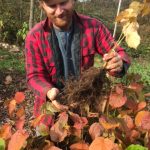
About Jonathan McRay
Jonathan McRay is a father, farmer, facilitator, and writer in the Shenandoah Valley of Virginia. He grows beautiful and useful trees that cross-pollinate food sovereignty and ecological restoration with Silver Run Forest Farm, a riparian nursery, woodland collective, and folk school practicing agroforestry, watershed health, and restorative justice. As a facilitator and mediator, he supports grassroots groups and community organizations through conflict transformation, popular education, and participatory decision-making. Jonathan is also learning to give up erosive perfectionism in favor of joyful growth.
Hope Leans Forward | The Body as Grounded Wisdom
Hope Leans Forward | The Body as Grounded Wisdom
The body is our house—and how we live in it and where we
occupy it are uniquely ours, as well as being part of the common
human experience. The body is a treasure trove and an exquisite
vehicle for our practice of waking up and being with what is.
—Jill Satterfield
My grandmother, Lillian, like my mother, was a domestic and tough, but she also had a tender side. I absorbed her toughness more than her tenderness, even though I admired her tender side. When they came, the tender moments took me by surprise, and I cherished them. We had a ritual every week where she would get out the foot basin and the Wray & Nephew overproof white rum. My job was to wash and massage her feet with the rum. She believed white rum would cure her debilitating arthritis, and I felt special, being asked and sharing the time.
Her feet were muscled, boxer-like and built, evidence of a hard life of little ease. At that time, she was well into her seventies, youthful by today’s standards, but back then, she was worn out, nearing the end of her life. Consciously or not, I absorbed many messages from this ritual. Two stand out. First, it’s exhausting to be a Black woman; it runs your body into the ground. Second, self-care is essential, indispensable when life is hard. She deserved, she earned, this moment to care for herself and for her body.
This memory lingered in me when decades later, following an intuitive sense that I needed to care for myself in a different and unaccustomed way, I began studying Kundalini yoga. My work was punishing my spirit and my body, and I needed to find a way out of the mess. I had worked myself into uterine fibroid tumors that eventually contributed to several miscarriages. While I received medical treatment, there was no safe place for me to talk about what was happening to my body. I joined a support group for women who had experienced miscarriages, but I felt isolated as the only Black person in the group.
To heal myself from the pain, I created rituals of healing, much like my grandmother did with me. I attended retreats for women who had experienced miscarriage. I lit candles. I prayed. I read books on loss and grief. Yet all this and more couldn’t dislodge the grief that had me like a straitjacket. It wasn’t until I traveled to Japan on the eighty-eight-temple pilgrimage of Shikoku that I began to heal, an experience I described in my first book, The Road That Teaches: Lessons in Transformation through Travel.
Our pilgrimage began in Osaka, and we took the high-speed train to Mount Koya, or Kōya-san, a World Heritage Site and the birthplace of Kobo Daishi, the founder of the Shingon school of Buddhism. The pilgrim officially begins at the temple gate at Koya as a symbolic act of commitment. Passing through the gate, the pilgrim takes a vow to complete the pilgrimage, not just for themselves but for the benefit of all beings. With moss-covered rocks, the scent of incense, the sound of temple bells and fast-moving water down forested hillsides, Mount Koya is a “thin place,” where the material and spiritual world meet.
As I entered the graveyard and passed through the temple gate, I bowed. The cemetery was partly dedicated to Jizo Bodhisattva, the Japanese deity said to aid pregnant women and travelers. Jizo is the caretaker of deceased infants and children, including fetuses lost to miscarriage and abortion. Hundreds of stone statues of Jizo line the cemetery stone walls. Some wear handsewn capes and hats, others stand atop mossy rocks, and still others receive a love note written in longing and loss. A damp teddy bear, a bouquet of faded flowers, yet another story of loss and love.
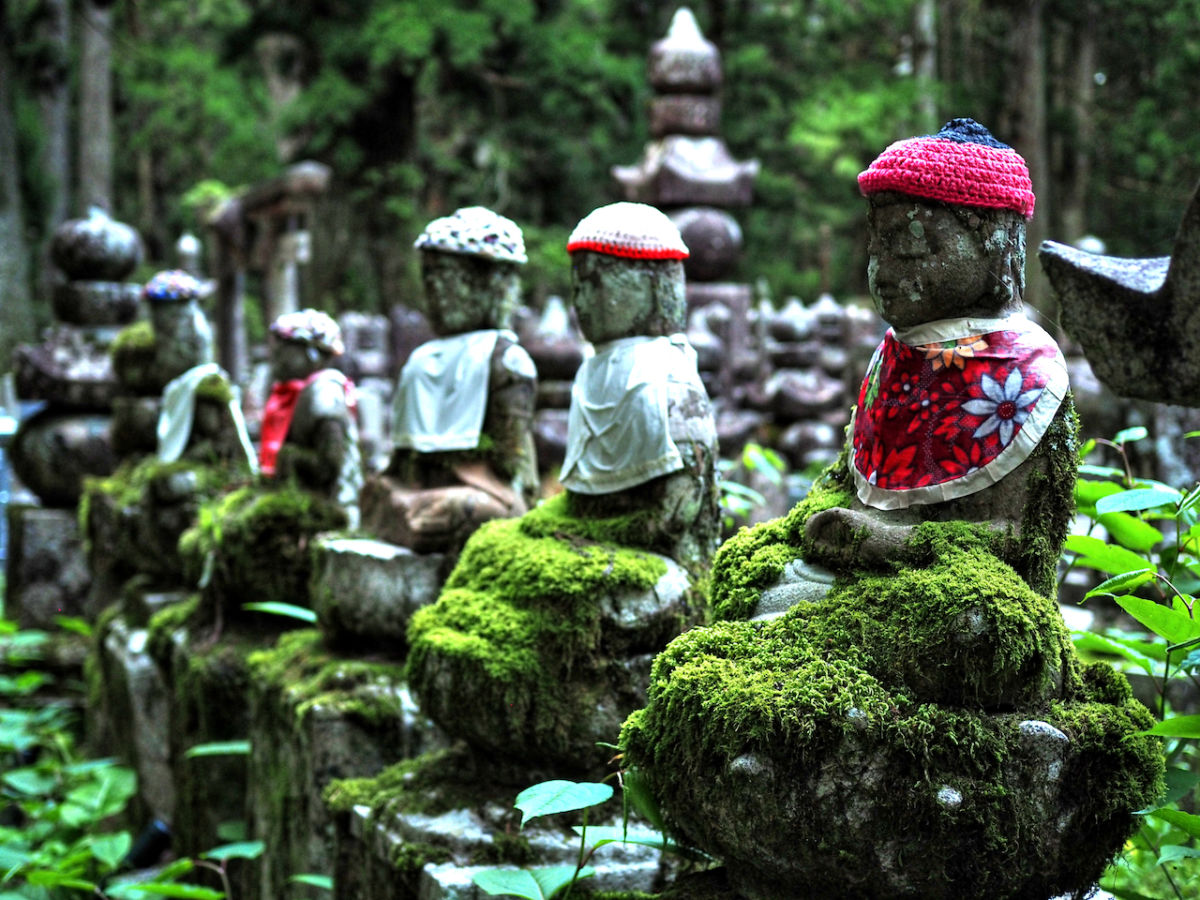
For years after the miscarriages, I felt barren and broken by the loss, shame, and guilt. There was a ragged, dispossessed part of me that I couldn’t shake. Here in the cold spring dampness of Kōya-san, my loss and grief were acknowledged and shared, not by a handful of people sitting across a table in the basement of a hospital support group, but openly by a culture and a people. I sensed that those in the cemetery around me understood and, unlike the support group, made space for the grieving to be and to breathe. The Japanese people recognized and honored the grief of miscarriage and abortion through this cemetery and these healing rituals, which said to me, What happened to you happened to us. What you’ve done, we’ve done. You are loved here. You can heal here. All of you is accepted, loved here.
The loss from the miscarriages is still there, though less so; less chokingly devastating, but there. Looking back now, I realize that in some ways, the miscarriages were fueled by fear of further loss, of the uncertainty and fragility of relationships that held me back from loving and being loved. I kept second-guessing myself with questions: Was it my unrelenting drive to “succeed”? Was it the running from poverty and toward a legal career? Was it the years of weight training and intense exercise that had eventually molded my body into an impenetrable shape? The one thing I did know was that the healing I was seeking wasn’t in the support groups with people comparing and one-upping their loss. The beginning of my healing started in a very unlikely place, halfway around the world in a cold, damp cemetery in Japan, where the collective grief was free to breathe and be held by everyone. With all this, I arrived at my first Kundalini yoga class: tough-minded and tough-bodied.
I started studying and practicing Kundalini yoga at about the same time I began studying meditation in the Plum Village tradition. Yoga and meditation were part of my healing process after a surgery for the uterine fibroid tumors, after my painfully short first marriage, and while pinned beneath the weight of my Big and Important Job as a lawyer-lobbyist.
As I began to practice yoga, one of my first realizations was that my breath and body were frozen and rigid, like a block of ice. I could barely turn my spine from left to right. My fingers dangled a couple of feet away from the ground as I folded my body forward, my hamstrings screaming with tension. Most shockingly, I couldn’t feel my breath.
My years of living an intellectual, success-driven life set me up for intellectual breathing. I was largely in my head, cut off from the wisdom of my body. My breathing was frozen. I was so focused on “getting there” as opposed to “being there,” and had spent so much time trying to outrun poverty and prove my own worthiness to myself and others that I had forgotten how to breathe. My breath, mostly in my upper chest, was shallow, and I recruited the secondary respiratory muscles of the neck, upper chest, and shoulders instead of the primary respiratory organ of the diaphragm, abdominal muscles, and the intercostal muscles between the ribs. I had forgotten how to breathe with my whole body.
In studying yoga, I recognized and acknowledged patterns from decades of living remotely in my body. In law school, I studied torts, evidence, commercial law, but I learned nothing about my body, the breath. And years of working hunched over a computer left me nearly inflexible in body and spirit. Though breathing fully and completely lies at the very center of life, I was stuck in a shallow pattern that mirrored my stressful life. With Kundalini yoga, I set out to reclaim my breath and my body.
Before I began Kundalini yoga, I experienced chronic pain in my jaw, upper back and shoulders, and sides of my neck from poor breathing and a habit of bracing myself, which even affected my mood. Unconsciously clenching muscles in the anal sphincter affected my back and shoulders. I was hyper-vigilant and impatient with a nasty edginess. Even today, when I have a flash of impatience, I still catch myself and notice that my breathing tracks the feeling in my body. I feel my breath weak and uneasy.
After my return from Japan, I began reading the books of Judith Hanson Lasater and Donna Farhi, long-time yoga teachers, and then took breathing-focused classes with them. In The Breathing Book, Farhi points to several important characteristics of “free breathing,” which helped me understand the crucial, essential link between the mind, the body, and the breath. It was time to practice, even though I had plenty of resistance and plenty of skepticism. I’d lie on the floor with my knees bent or resting the back of my knees on the edge of a chair and listen to myself breathe. I felt dumb, like “This is a total waste of time.” I thought, “I could be squatting or deadlifting weights. I could be walking seven or eight miles, uphill. What am I doing here?”
I’d force myself to lie there being still, waiting for something, anything to happen, waiting for a signal. I stuck with it, and after a couple of weeks of this “do nothing” breathing exercise, one day I felt something. It was my breath but not in my chest and shoulders. I felt it at my reproductive organs and below the navel. It was like my body was opening and closing to the rhythm of my in- and out-breath. Oscillating, at first the breath was moving my tailbone and then rolling upward and outward to my shoulders and hands and then downward and inward to my legs and feet. Like boneless seaweed, the breath moved higher and lower, left and right, circular and in, multidirectional, then becoming calm and effortless. Through quiet attention, patience, and perseverance, this bruised and battered part of my body was beginning to move in freedom and harmony.
Slowly, incredibly slowly, I was being invited to trust and allow the breath to emerge and to release naturally. As I practiced this “do nothing” breathing, these words came to me:
Allowing ease and release
Allowing body to soften
Allowing breath to know ease
Allowing kindness
Allowing in-breath to meet the out-breath
Allowing pause between the in- and out-breath
Allowing lungs to be free
Allowing belly to be free
Allowing the heart to be free
Rise
Fall
In
Out
Deep
Slow
Breath.
As I invited the breath, I was being invited to inquiry, not only about my body, but also about my hard-driving life, my values. As I began with this foundational breath and body awareness practice, I retrained how I was breathing. And as I did, a lot of my chronic neck and upper-back pain was alleviated. But more importantly, through the breath, the real me—the vital me, the whole me—was rediscovered. I had found a different kind of intellect, a wisdom from inside my body that felt whole and right.
* * *
“Do nothing” breathing is now one of my most important rituals and I offer it to individuals in my coaching and leadership work, as well as to groups on retreat. Several years ago, I was invited to open the annual conference of Spiritual Directors International with my dear friend Karen Erlichman, and we offered a version of the “do nothing” breathing. The grand ballroom was packed with maybe six hundred people all practicing the breath I stumbled upon at the height of disconnect from my body. Most people were standing with their hands on their belly, breathing. Some people were laid out on the stage flat on their back, eyes closed, following this essential breath back, way back to an essential part of themselves. Still others sat in chairs, gently swaying from side to side. It was beautiful. Here’s what we did:
“Do Nothing” Breath Inquiry Practice
Choose what’s best for your body to sit, stand, or lie down, and allow yourself to get in a comfortable position.
- Allow your eyes to be open or closed. Notice what feels most comfortable.
- Notice the shape of your body without judging yourself.
- Feel your feet on the floor if standing.
- Feel your legs, hips, torso, arms, chest, face.
- Allow your spine to relax, and become aware of the back, sides, and front of the body.
- Bring your attention to your breathing.
- Feel the breath come in and go out.
- Notice and feel the in-breath.
- Notice the pause between the in- and the out-breath.
- Notice and feel the out-breath.
- Feel the belly rise and fall.
- Practice gently bringing your attention back to the sensation of breathing; feel the rise and fall of your belly.
- Feel yourself breathing in and out.
- Imagine your body like boneless seaweed with roots, grounded yet totally free.
- Notice how you’re feeling physically, mentally, emotionally, and spiritually.
- Take a moment to sense your breathing and ask yourself, “Where do I feel my breathing?” and simply wait.
- Return to the question over and over: “Where do I feel my breathing?” Let whatever perceptions you have be here without editing them. Don’t discount tiny movements.
- Place one hand on the belly and the other at the chest or any place on your body, if that’s appropriate for you, and feel the movement of the hand at the belly and at the chest or that part of your body.
- Ask yourself, “What does my breath feel like?” and simply wait without judging yourself. Gently keep returning to this question: “What does my breath feel like?” Become aware of words or images that might arise to describe your breath. Again, let whatever perceptions you have be here without editing them.
- Return your attention to the body and mind, gathering an impression of how you are doing at this moment. There is no need to change or edit this moment.
- When you are ready, stretch gently to close this practice and notice how you feel.
My grandmother had little chance to practice “do nothing” breathing. Yet our ritual of washing her feet with white rum taught me that you’ve got to make doing nothing a major priority, no matter what. And I do and will continue to practice that for her now.
Excerpted with kind permission from:
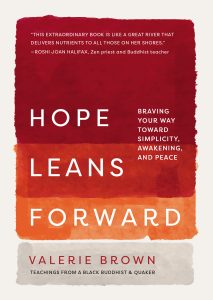 Hope Leans Forward
Hope Leans Forward
Braving Your Way toward Simplicity, Awakening, and Peace
by Valerie Brown
PUBLISHER Broadleaf Books
PAGES 275
PUBLICATION DATE November 8, 2022
Recipient, Nautilus 2023 Gold Award for Eastern Spirituality
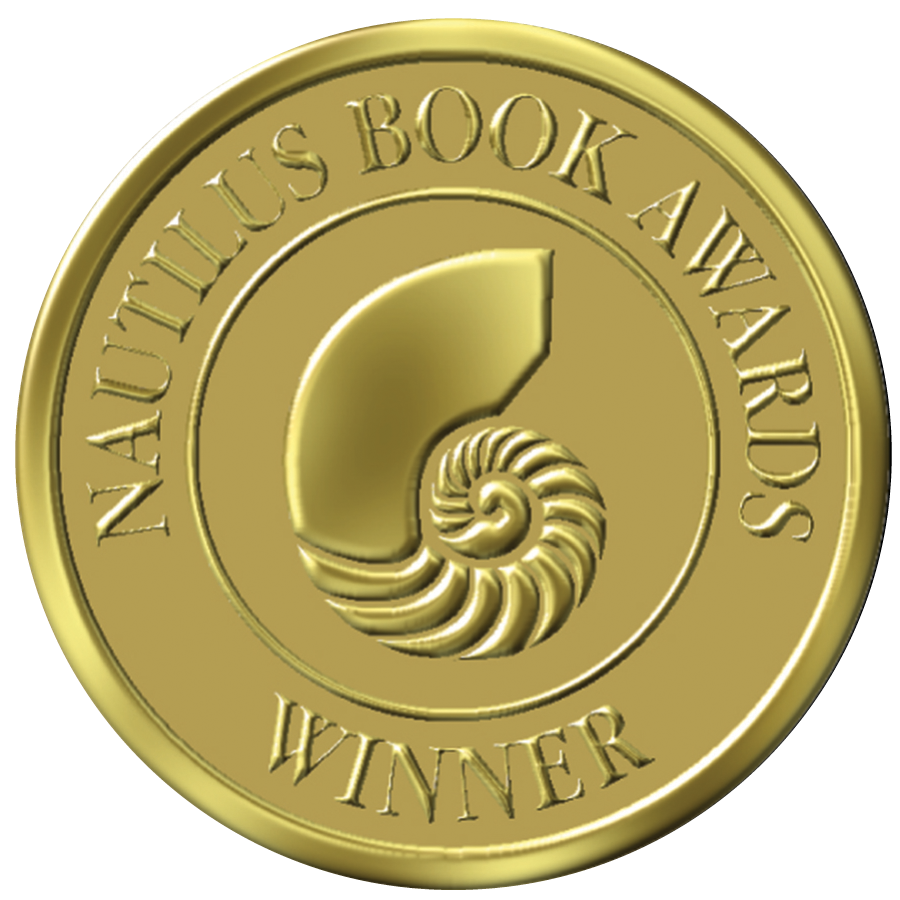
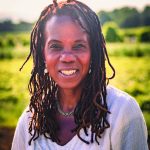
About Valerie Brown
Valerie Brown a Buddhist-Quaker Dharma teacher, facilitator, and executive coach. A former lawyer and lobbyist, she is co-director of Georgetown’s Institute for Transformational Leadership as well as founder and chief mindfulness officer of Lead Smart Coaching. She is an ordained Buddhist Dharma teacher in the Plum Village tradition, founded by Thich Nhat Hanh, and is a certified Kundalini yoga teacher. In her leadership development and mindfulness practice, she focuses on diversity, social equity, and inclusion. Brown is an award-winning author whose books include Hope Leans Forward, The Road That Teaches and The Mindful School Leader with Kirsten Olsen. She holds a juris doctor from Howard University School of Law, a master of arts from Miami University (Ohio), and a bachelor of arts from City University of New York. Brown tends a lively perennial home garden in New Hope, Pennsylvania.
A Cosmic Twist
A Cosmic Twist
Look up into the clear night sky, and after a time you will perceive how the stars rotate around a central axis, as if on a great wheel. The ancients saw this rotation as the movement of a cosmic spindle, with its whorl in heaven and its shaft, the axis mundi, invisibly extending down to earth. Life and destiny were the threads spun by this spindle, the fabric of the world woven by the movement of sun and moon, stars and planets.
This image is remarkably universal. In The Republic, Plato beautifully describes the “spindle of necessity,” suspended from a rainbow-colored shaft of light, with an eightfold whorl of stars and planets, all singing in eternal harmonies, while the Kogi people of Colombia tell how the Mother Goddess set up a giant spindle to penetrate all nine layers of the just-created earth, still soft and unstable, which then solidified around it. The cosmic spider spins the world into existence in myths found all over North and South America, Africa, and Asia, and fate-spinning goddesses include the Germanic Norns, the Greek Moirae, and the Roman Parcae. In an apocryphal story, the Virgin Mary spins and weaves the veil of the Temple, which is the cosmos. 1
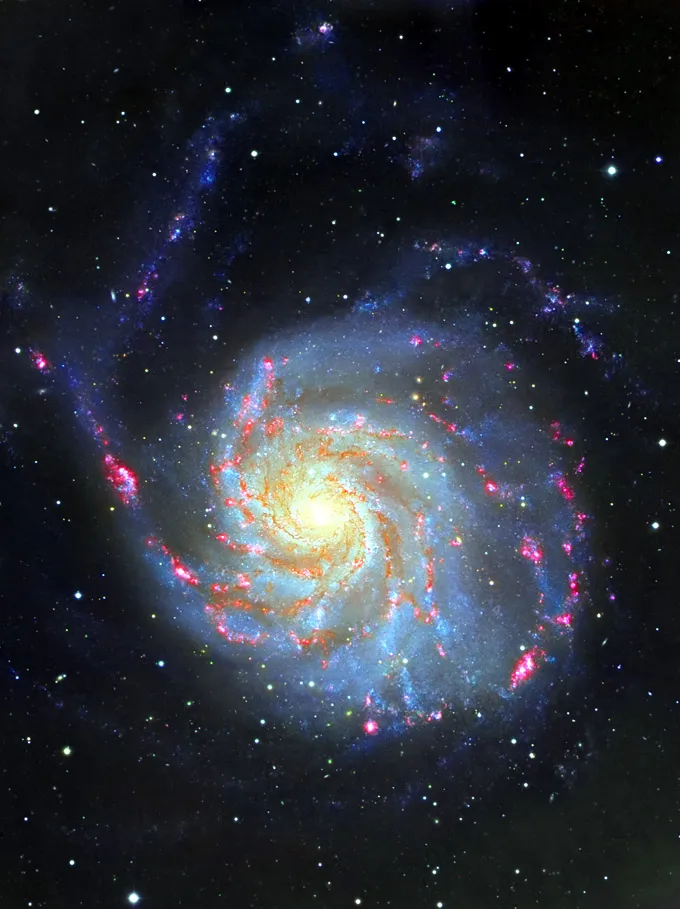

The primal activity of thread-spinning has become distant and unfamiliar to us today, through the mechanization of fabric production, but it is not difficult to recover a sense for it. Take a lock of sheep’s wool, which you can obtain from a craft store or fiber market, or perhaps even in its raw condition from a farmer. Carefully tease and puff out the short fibers until they form a fluffy ball. Starting at one point on the surface of this ball, pull out a small portion of the fibers, twisting them with your fingers. Keep pulling and twisting, gradually taking up more of the fibers, until you have a length of thread, or more likely a lumpy, unwieldy strand of thick-and-thin yarn—which may not be beautiful, but is nevertheless a transformation of the disorganized substance you started with.
You’ve just practiced one of the oldest of human handcrafts, dating back around 30,000 years, which, as we have seen, represented for our ancestors a human mirroring of the forces of the cosmos. When people became spinners, they were not merely serving a mundane need for clothing and shelter; they were establishing themselves as creators, bringing their own activity into play to shape the products of nature, no longer passive recipients or victims of natural events. Spinning brings a cosmic “twist” into the raw materials we encounter upon earth, giving them strength and continuity, and in so doing, the soul of the spinner is transformed, as well.
 When we spin a thread, we are actually creating an extended, attenuated spiral, and the spiral is a cosmic form that repeats itself on all levels of our living world, from the shape of our galaxy to the helical structure of our DNA. More tangibly, spirals can be found everywhere in nature, in whirling clouds and swirling water, in unfurling fern fronds and seed-filled sunflower heads. Even the hair on the back of our own heads grows in a spiral pattern. The uneven, rotating crimp of sheep’s wool is actually what makes it much easier to spin than smooth fibers like cotton and flax; the wavy fiber complements the movement of the spindle, and locks the spiral structure in place.
When we spin a thread, we are actually creating an extended, attenuated spiral, and the spiral is a cosmic form that repeats itself on all levels of our living world, from the shape of our galaxy to the helical structure of our DNA. More tangibly, spirals can be found everywhere in nature, in whirling clouds and swirling water, in unfurling fern fronds and seed-filled sunflower heads. Even the hair on the back of our own heads grows in a spiral pattern. The uneven, rotating crimp of sheep’s wool is actually what makes it much easier to spin than smooth fibers like cotton and flax; the wavy fiber complements the movement of the spindle, and locks the spiral structure in place.
The spiral dances of the moving stars and planets were tracked by ancient astronomers, and humans very early took up this motif in their artworks and cultic images, chiseling spirals on passage tombs in Ireland and rocks in the Arizona desert, carving them on Chinese jade animals and the Ionic column capitals of Greece. The originators of the art of spinning must have felt that they were echoing the forming of matter by cosmic forces.
Tools were soon invented to make the process quicker and the products more consistent. Probably first a stick was thrust into the fibers, which could then be rolled down a thigh instead of doing all that tedious finger-twiddling. This is something you can also try out yourself, using a small, smooth stick with a hooked end that you pick up in the woods and trim to suit your needs. A more complicated development involved using a length of spun thread to tie a flattish, roundish stone together with a protruding stick, thus making a weight to drive the turning motion and a handle that could be used to start the stone spinning, as well as to wind the thread around as it was produced. 2 In time, this evolved into human-crafted spindle whorls and shafts, which give us Plato’s cosmic image, and the spindles of countless fairy tales.3
Spinners were imitating a divine process, and their work and their tools were always invested with symbolic meaning. The discovery of a spindle made of precious silver and gold in a Neolithic grave site in Anatolia, Turkey, demonstrates just how far back this symbolic, ritual significance extends. Meanwhile, the familiar stories of spindles and spinning that have come down to us often make clear that dangers and risks are involved in such an undertaking. If performed without reverence, it could lead to disaster.
In “Mother Holle,” for example, a story about two stepsisters, the industrious spinner reaps a golden reward, while the one who is too slothful to complete her task is punished with a hideous fate. This is more than a cautionary tale intended to frighten girls into fulfilling their societal roles, for as Jacob Grimm himself described in his Teutonic Mythology, Mother Holle is a manifestation of a Germanic nature-goddess, Hulda; it is said that snowflakes are the feathers shaken from her bed. When the girls fall into her world by tumbling into a well, they enter into the world behind nature, the world of the elemental forces that cause snow and rain, growth and fertility. Diligence in spinning is a sign that one is worthy of taking up that cosmic task, of becoming a co-creator with the divine. The alert awareness and feeling-sense required for good spinning are equated with compassion; the good sister answers an apple tree and an oven that call out to her for help, while the lazy one ignores them. Her failure dooms her to be covered with pitch, an outer sign of her inner insensibility.
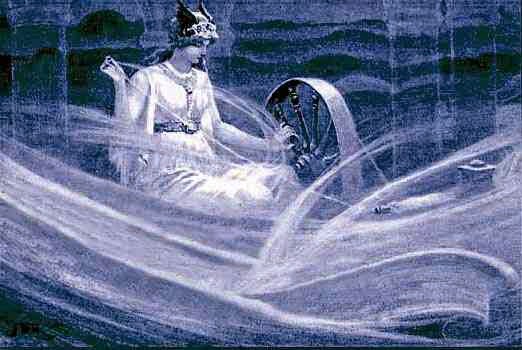
Mechanization and materialization of the cosmic spinning activity can also lead to dire results, as shown in the tale of “Rumpelstiltskin.” In this story, the girl is a poor miller’s daughter, and the mill, like the spindle, is a wheel that resonates with the cosmic motion of the heavens. But rather than a simple tool for bringing order into chaos, it is a huge machine that crushes and pulverizes the living grain into a lifeless powder, rendering the miller poor indeed. To return life and value to this material, turning it into bread, would require a further step of transformation, of hard work and patience, but instead of humbly acknowledging this, the miller is moved by an impulse of worldly greed. He makes a wild claim that his daughter can spin straw into gold, and a grotesque trickster figure steps in to do it. Faced with her impossible task, unable to admit her inadequacy, the girl enters into a bargain with the subhuman creature.
When he claims her child as his reward, the girl, now a queen, has to earn back her life-giving power of transformation. And this time the way is through language, through naming. She must name the unknown and feared element in her life, must know it intimately, in order to overcome it.
It’s no accident that spinning is associated with language, that we speak of “spinning” a tale or telling a “yarn.” This, too, represents a step toward cosmic awareness, a human participation in the processes that create our destiny. When we look at events with such a higher awareness, we can perceive the links between them and come to a better understanding of their true essence. Spnning is rescued from falling into a mechanical search for material gain, and transformed into a quest for meaning and knowledge.
As anyone who has tried it knows, spinning is not a mindless task. It requires constant attention not to end up with a broken thread or a tangled mess. At the same time, the rhythmical balance of hand and mind working together is deeply satisfying and calming. The spinner may find her own thoughts changing, becoming organized along with the fiber, leading to new inspirations and insights. An inner “golden thread” can be sensed, one that connects us to the cosmic rhythms which created us.
This is the value we can give to our own lives, when we accept what we have been given, and shape it in wise accordance with cosmic laws, rather than attempting to deny or subvert them. In taking the latter course, we spin ourselves into another form of disaster. When in the story of “Briar Rose” or “Sleeping Beauty” the king hears a prediction that his daughter will prick her finger on a spindle and fall into a deathlike sleep, he attempts to avert that fate by burning all the spinning wheels in the kingdom. Ignorance cannot turn away a hard destiny, though; the princess’s curiosity leads her to touch the first spindle she sees, ironically bringing on the very doom the king tried to avoid.4
A better solution is to observe, learn from, and imitate the cosmic rhythms that we perceive, and to create useful products full of beauty and harmony, rather than lusting after wealth and power. In “Spindle, Shuttle, and Needle,” a king’s son is searching for a bride, who he declares must be at once the richest and the poorest. He comes to a village where he is directed to the richest girl, but moves on with hardly a glance for all her finery. The poorest girl, meanwhile, is sitting and spinning all alone in her little house; he likewise glances at her and rides away, but she looks after him until he disappears, and opens her window.
Remembering verses that her godmother used to say when she taught her the handcrafts that now form the basis for her livelihood, the girl sends out her spindle, shuttle, and needle as messengers to the prince, trailing marvelous fabrics behind them. He recognizes that his destined bride is this girl who is at once the richest and the poorest: poor in material wealth, but rich in skill and wisdom. They are married with great joy, and the tools of her labor are kept with honor in the treasury of the kingdom.
It is tempting for us to turn to external, mechanical solutions for our problems today, but human ingenuity and honest work never lose their value, when coupled with reverent appreciation for the rhythms of nature. If we can become loving creators, spinning the threads of life in harmony with the turning wheel of the cosmos, then the promise of all the ancient tales will be fulfilled, and their dangers averted.
NOTES
(1) For these and many other fascinating references to the lore of spinning and weaving, see Michael A. Rappenglick, “Cosmic Spinning and Weaving: Making the Texture of the World” in Archaeoastromy in Archaeology and Ethnography, edited by Emília Pásztor (Oxford: Archaeopress, 2007).
(2) In the short film “On Handwork” (viewable at https://www.youtube.com/watch?v=bfoByYLSBY8&t=43s&ab_channel=ChuckSmith), Renate Hiller demonstrates spinning with a stone tied to a stick, along with explaining its cosmic and human significance. I am indebted to Renate and her colleagues at the Fiber Craft Studio for teaching me much about both the practical and spiritual aspects of spinning.
(3) This tool, the handspindle, has been in use for over ten thousand years, and is still widely used today. The spinning wheel is only a few hundred years old. The many tales that feature spinning undoubtedly come from origins far earlier than their written incarnations, and would originally have referred to the older tool. This makes sense of a “Rumpelstiltskin” variant in which the girl is spinning on the roof (easy with the highly portable handspindle, not so much with a wheel).
(4) This tale may also have originally referred to a handspindle, or to an older type of hand-turned spinning wheel. Modern treadled spinning wheels seldom have sharp parts.
The four fairy tales referenced in this essay can all be found in the collection of the Brothers Grimm. Among other sources, the stories can be accessed on the site of D. L. Ashliman, https://sites.pitt.edu/~dash/grimmtales.html: “Frau Holle” (#24), “Little Brier-Rose” (#50), “Rumpelstiltskin” (#55), “Spindle, Shuttle, and Needle (#188).
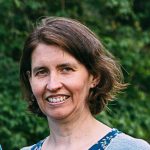
About Lory Widmer Hess
The Penetrating Wind
The Penetrating Wind
In the middle of a multi-month class offered by the Resonance Path Institute in 2019, which introduced a brilliant and refreshing interpretation of the Chinese Oracle of Change (I Ching), I discovered by routine annual medical tests that I had contracted a rare and ominous blood disorder. My immune system was attacking my bone marrow. According to the method offered in the class, I solicited the wisdom of the Tao. The result profoundly influenced my response to this shocking news.
At 72, I could claim some of the usual conditions associated with aging, but I was largely asymptomatic. I had been healthy and vigorous all my life—until suddenly I wasn’t. Life was now bringing me into a more direct and immediate encounter with mortality than I’d ever known. To my knowledge I had done nothing to bring about this condition, but neither was I powerless to address it. While it was a huge shock to discover, I decided it would not define me. The entire experience appeared so suddenly and progressed so rapidly that I was compelled to search for wisdom I could apply immediately. My consultation of the I Ching produced the representation of change in the form of two hexagrams: Hexagram #57, The Penetrating Wind (also named Peace) and Hexagram #18, Decay. I found it a shock that the hexagram #51 is related to #57, even considered by some to be the cause of #57.
The shock was the shock of failure. Not that I had failed at something specific. More likely, the most frequent and universal failure is to forget that our lives are influenced by a much larger dimension beyond routine comprehension or control—a perspective precisely revealed by the I Ching. The impact of that realization can occur suddenly and unexpectedly in small or large ways, some of which may be life-shaking. Not that determinism is the rule, just that the universe of choice we occupy is much smaller than we imagine.
Generalizing from my own experience may be precarious, but I felt as though blinders, the accumulation of micro-delusions, complacency and ignorance had suddenly been shattered. That shattering of my narrow view was like cleaning decades of grime from my windshield. The aftermath was as one would expect, a moment of clear vision. I saw the world with fresh eyes. Lifting the veil of this forgetting is a complex proposition. It’s a challenge to overcome our persistent conditioning—being colonized by the techno-materialistic paradigm—and to remain in contact with all that we are. It is also a step toward accepting the inevitable disconnect between our presumed individual agency and the reality of being subsumed within the wholly integrated, uniformly vibrant, and constant action of all Life beyond our control.
I discovered that health, my health and that of the collective, is a function of being mindful of this view of agency and applying myself accordingly.
To be released into the visceral certainty of being connected to everything is to become receptive to the influences of everything upon me. That my actions reach far beyond a parochial view is confirmed. I am reminded that the boundaries of those actions are virtually non-existent, that everything is always in intra-active motion. I cannot assume as much choice about how my life unfolds as I might imagine or prefer, nor can I ignore the probability of influence from far beyond my limited view.

The first thing to notice about Hexagram #57 is that it shows identical upper and lower trigrams. Another name for this hexagram is Peace, with both trigrams representing wind. Wind over Wind. I could easily assume the word ‘Peace’ assigned to Hexagram #57 refers to a static condition, stillness. We are inclined to define peace in our personal lives as stillness, no? The pace of change slows. But of course, peace is not stillness. The flowing dynamic of change never ends, and much of the time we are swept along with no sense of control.
To rely on that image of stasis sets up flawed interactions and a flawed sense of being. It’s more useful to regard the Penetrating Wind as a deliberate intention and submission to a persistent consciousness combined with intelligence and patience. Hence, I came to regard peace as the arrival of a Gentle Wind perpetually working at all levels of my existence, from the intra-cellular to the macro-social to the planetary. The Gentle Wind never stops. The image of wind over wind might be paraphrased as the changing nature of change. It operates in the subtle body and in the collective unconscious. It’s the Wind that carves mountains; the force changing the course of rivers. I am invited to become the penetrating wind to myself, to calm down, to take small steps—even in the face of the apparent urgency of a dangerous medical condition. I was being reminded that peace is the capacity to adapt to the constant arising and disappearing of all phenomena, continuously restoring equanimity rather than bouncing like a cork buffeted by every shifting current.
The power of the Gentle Wind was a message about recovering balance and integrity even in the face of difficulty. I slowed down. I was being given time to see things in a new way. The nature of this capacity was, and remains, reverence and humility. I was being acted upon by the Gentle Wind as much as acting as the Gentle Wind upon myself. I was being taken out of rational mind and the habitual ways of interpreting reality to a greater wisdom, the power of wu wei, non-doing.

I am being carved in this moment. I am restored to balance in every moment. Reality is undergoing innovation in every moment. Decay is happening at every level. The impact of decay in my life depends on my orientation to it. Do I react? Do I try to push it away or deny it altogether? If I am stuck in a static image of reality, reaching to restore that image, I am misinterpreting my role, my capacity, and the nature of change. This is the essence of grasping.
Hexagram #18 has a character of growing and unchecked decay as well as a shamanic power capable of calling forth an innovative remedy. It’s about summoning, not about conquering. It is not about killing, but about holding space for something to die. Something is always dying—even if it’s the source of my red blood cells. I am called to be patient, to embrace the monster, to experience whatever grief and loss may arise while creating and allowing room for a correction. This is the shamanic promise of Decay.
Coming to Peace (#57) is a return to stillness, integrating the reality of Decay into awareness, which is never still. As part of my experience of the Wind of Change, I see it working in my body, in my life and in the world. In that stillness is the exquisite paradox of actively forming and being formed, of continuously accepting the death of what is dying, embodying the agency of the shaman to fuel the adaptation, the growth, the innovation required in the present, continuously coming into a new balance between what I believe my agency to be and turning passive acceptance of what I do not comprehend into a transformative force, no more and no less powerful than the Penetrating Wind itself. Continuous composting.
As I entered a treatment regime, which was not guaranteed to work, I invoked the energy of the shaman, casting off an old way, bringing a new vitality to the hidden somatic-plane, inviting him to become his own remedy, to become a seed in the midst of his defeat, his subjugation to vast natural forces operating in incomprehensible ways, accepting the Decay while harnessing the Gentle Wind with reverence and humility beyond the exercise of will. All things come spontaneously into balance, constantly redefining homeostasis.
In terms of fundamental forces expressed in this pair of hexagrams, I interpreted the change reflected in the paired lines to illustrate the rational mind becoming a bridge between the physical and the metaphysical. Spirit lifts us to a greater view beyond the decay and makes room for the innovation and restorative force of remedy.
Witnessing this dynamic between these two hexagrams, Peace and Decay, suggests that every pair of hexagrams we may encounter in the I Ching, seemingly appearing in direct reference to us as individuals, express a bottomless well of the wisdom of the Tao that has nothing whatsoever to do with us as individuals.
The non-dual map of reality offered by the Tao is limitless. How we understood a seemingly discrete dynamic expressed as a pair of hexagrams depends on the questions we ask. In retrospect, I don’t recall ever asking “How is this pair an expression of the Tao?” I, like most everyone else, fell into the habit of seeing a pair of hexagrams as a reference to me, a progression from one state to another, because we are normally oriented to the identity we know as me. But our interaction with the Tao is greater than that. It is non-linear and points to a perspective beyond any individual circumstances.
There is both fantasy and reality to my dream of personal efficacy. To accept limits and to realize the true sources of that efficacy is to acknowledge the influence of everything and everyone upon me. The arrival of this condition and my continued precarity has awakened me to something I had hidden from myself and from the world: a subterranean river of power and clarity whose essence and purpose runs deeply through everything I am and all I do. Yet even this is also not about me. I am a being lifted out of his own story into the realm of Being.
I continue to balance on shifting ground. I may turn toward denouement at any time or merely persist as the appearance of normal aging. The only response to the shock of realizing the natural harmony of Peace and Decay is love – magnificent, universal, unconditional, pure, and unstained. That river has now burst forth, erupting in this transformative moment. There is no time left for distraction or procrastination, no time for zigzagging, excuses, or dancing around the truth. There is no benefit to grasping for selfish personal ends, no promise lying in half-measures. The present moment is the right time, the only time to embody the shamanic power of restoration, acting as a Penetrating Wind in the world while recognizing that force is inexorably working in our own lives.
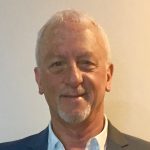
About Gary Horvitz
Move back and forth into the change.
What is it like, such intensity of pain?
If the drink is bitter, turn yourself to wine.
Navigating the Storm of Global Change
Navigating the Storm of Global Change
I’ve long championed the term “subtle activism” to describe the application of consciousness-based practices like meditation, prayer, and ritual for collective rather than personal transformation. The idea is to broaden the traditional focus of our therapeutic and spiritual attention beyond individual concerns to include the main global issues of our times. And it is in relation to the healing of collective trauma, specifically, that I think an approach like subtle activism has a crucial role to play.
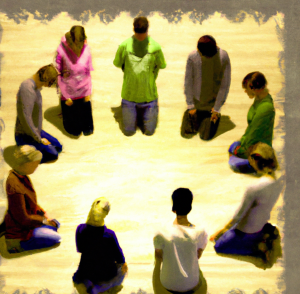 As I mentioned in Part 2 of this series, one of the most exciting developments taking place at the leading-edge of consciousness work today is an exploration of the emergent spiritual capacities of coherent forms of group consciousness. When a group of sovereign individuals voluntarily pool their consciousness together to form a coherent group field, they access depths of compassion, love, and courage exponentially greater than any one individual can reach on their own. As a result, the field becomes a conduit for healing powers of extraordinary magnitude.
As I mentioned in Part 2 of this series, one of the most exciting developments taking place at the leading-edge of consciousness work today is an exploration of the emergent spiritual capacities of coherent forms of group consciousness. When a group of sovereign individuals voluntarily pool their consciousness together to form a coherent group field, they access depths of compassion, love, and courage exponentially greater than any one individual can reach on their own. As a result, the field becomes a conduit for healing powers of extraordinary magnitude.
This principle has been at the center of my work for over a decade. When working with groups in this way, it becomes obvious that the wisdom and power of the group field has the potential to help transmute not just the personal traumas of individual participants but also our collective historical wounds. The profundity of the field introduces a crucial dimension of depth that enables us to touch these historical wounds with compassion, without becoming overwhelmed or reactive.
Such a process also tends to make clear that, in the depths of our being, we are all embedded in relational fields that carry trauma. Some of us might have inherited circumstances that enable us to manage those wounds more effectively than others, but the deeper we go in our healing journey, the more we realize that none of us can escape the traumatic history of human conflict. While it can be crucial to acknowledge the differences in our cultural situations, past and present, ultimately we share a spiritual wound of separation that can only be healed by an experience of profound belonging. Recognizing this, we become intrinsically motivated to help liberate each other.
One of the obstacles, though, to recognizing the social healing potential of these new approaches is our tendency to understand spirituality through the lens of the dying era, rather than the one being born. Since the scientific and political revolutions of the 1800s, modern spirituality has been largely confined to the private realm of subjective experience, separate from the secular public spheres of science, politics, and culture. This was arguably necessary at the time to free the modern mind from the constraints of religious dogma. But we are undergoing another revolution today at least equal in magnitude to the one that birthed modernity. Everything is up for revision, including the modern marginalization of spirituality to the merely personal realm. In this context, we can start to imagine new forms of (healthy, non-dogmatic) spiritual expression that straddle the private and public spheres, partly as a way to offer a more profound holding for the complex wounds that are rising to the surface as we transition to the new era.
Yet we can participate in heartfelt collective rituals to help heal the roots of intergenerational trauma without supporting the acting out of these wounds in the cultural or political sphere. I find that many spiritually-oriented progressives have a hard time making this distinction. They feel genuinely called to participate in the healing of these wounds. So they believe on some level that when the trauma spills over into the public arena, their task is to bear sympathetic witness to whatever is happening, even if things get messy or weird. But the problem with trauma being acted out collectively is that it does have consequences. Innocent people and groups get hurt, and the cycle of reactivity continues. For genuine healing to take place, the trauma needs to be held in some kind of conscious public container. Then the wound can be fully met, but in a way that leads to the transmutation of that energy, rather than just its displacement onto others.
Further, and more seriously, acting out trauma is an invitation on the energetic plane for unscrupulous forces to exploit the situation to gain power and further division. One way this appears to be manifesting is in the spread throughout our mainstream institutions of a fundamentalist ideology whose premises cannot be questioned. Such a development threatens to undermine key foundations of pluralistic democracy we’ve long taken for granted, especially the freedom of speech.
Tellingly, the main justification for the censorship of speech used by proponents of this ideology is to prevent at all costs the triggering of pain associated with historical trauma. Any words that do so are seen to be a form of “violence”. Of course it’s a good idea to be kind to each other as much as possible. But when people are required to think and speak in a specific way at pain of losing their livelihood or being shunned from society, we are seeing the exploitation of trauma for the purposes of control. Far from bringing people closer together, the coercive nature of this approach breeds resentment and thus creates an obstacle to genuine intimacy. Left unchecked, it represents a familiar path toward totalitarianism. And given the rapidly expanding, AI-enhanced powers of centralized authorities to track and enforce ideological compliance, this is a non-trivial concern.
The bigger picture is that this diabolical outplay is taking place at a time when there is an existential need for the global power structure to be fundamentally transformed. Apart from anything else, the traditional top-down systems of centralized decision-making are simply not capable of managing the complexity of the problems that constitute the world meta-crisis, including humanity’s deeply imbalanced relationship with the natural world.
Astrology helps us see that this epochal shift is happening right on cosmic time, just as the Piscean Age gives way to the Aquarian. And so here we are, witnessing the sudden rise of determined, destructive forces on both sides of politics that threaten to dismantle the societal order as we’ve known it. In this light, we can recognize an evolutionary purpose hidden within the apparent darkness of the forces at loose in our world. On one level, the wisest path of action may thus be to just get out of the way and let the shit show take its course.
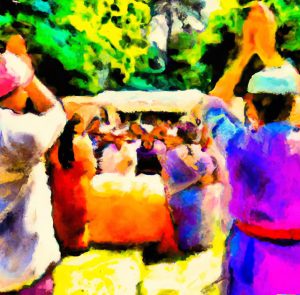 Yet I believe we can help transmute these conflicts on the energetic plane by engaging together in the work of healing historical trauma, both within ourselves and in the collective. Doing so is potentially like an aikido move where everyone can win. Healing collective trauma goes to the heart of the dynamics driving conflict and polarization. Complaining about the way that trauma is being acted out doesn’t really land unless we acknowledge the reality of the pain at the source of the behavior and meet it with profound love and compassion. On an energetic level, doing this work together can help to fill these open wounds with courageous and compassionate awareness, making the trauma less vulnerable to exploitation by unscrupulous forces. Done right, it can become a doorway to a deeply moving experience of the world-centric or Gaian consciousness wanting to be born out of the global crisis.
Yet I believe we can help transmute these conflicts on the energetic plane by engaging together in the work of healing historical trauma, both within ourselves and in the collective. Doing so is potentially like an aikido move where everyone can win. Healing collective trauma goes to the heart of the dynamics driving conflict and polarization. Complaining about the way that trauma is being acted out doesn’t really land unless we acknowledge the reality of the pain at the source of the behavior and meet it with profound love and compassion. On an energetic level, doing this work together can help to fill these open wounds with courageous and compassionate awareness, making the trauma less vulnerable to exploitation by unscrupulous forces. Done right, it can become a doorway to a deeply moving experience of the world-centric or Gaian consciousness wanting to be born out of the global crisis.
As I said earlier, new possibilities for the healing of collective trauma are coming online through innovative technologies that evoke the collective spiritual intelligence of coherent group fields. Such fields provide the deeper dimensionality needed to hold these wounds in all their complexity and sensitivity. I believe that many of these emerging group-oriented approaches are not merely Piscean Age practices adapted to modern times, but truly novel Aquarian Age practices designed for the coming era. They tend to be essentially democratic, for example, function seamlessly with digital technologies, and are entirely scalable. As such, they carry the potential to create a broader collective or global context that is crucial for the transformation of wounds that originated in the public realm.
But for these approaches to be truly integrative, they need to feel welcoming to all, not just progressives.
At a certain level of depth, these collective wounds live in all of us. Regardless of which angle we approach them from, we are touching the same trauma. It’s a highly reactive place for everyone. The container needs to be held with the utmost integrity so that people on both sides of any given historical conflict are able to trust the process. This means acknowledging tendencies toward defensiveness and denial on one side of the polarity, and toward victim consciousness and emotional manipulation on the other, while holding these patterns together in a profound field of compassion.
If these tendencies sound like typical patterns of male-female conflict, that’s to reiterate my point that the dynamics of polarization underlying our political discord reflect archetypal tensions between masculine and feminine dimensions of the collective unconscious. As noted, the extremes on both sides could be said to represent the more narcissistic or immature versions of these principles. Only the healthy and mature masculine and feminine principles, working together, have the power to push back against these dynamics. Only a united masculine and feminine can form the basis of a truly integral consciousness of the future. Our collective healing processes should aim to incorporate a level of integration that authentically honors both principles.
Of course it’s not an easy thing to do. We’re all wounded healers in these realms. The challenge from the left is that they have so demonized men and the masculine principle they tend to lack access to certain positive masculine qualities that need to be included in a healthy integrative response, such as the courage to call out an agenda of control hidden beneath gentle words of inclusion. The challenge from the right is that their devaluation of women and the feminine principle means they tend to lack access to certain positive feminine qualities needed in a healthy integrative response, such as the sensitivity to the subtler dimensions where these wounds reside.
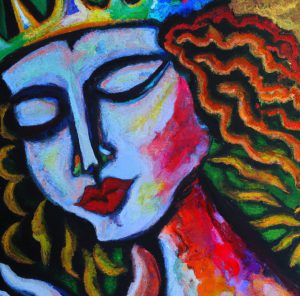 On the positive side, an approach to collective healing that incorporated the healthy feminine principle would be based on the dynamics of attraction rather than coercion. One might imagine groups or communities who have done their collective healing work radiating such obvious joy and fulfillment that more and more people become magnetically drawn to join them. An approach that incorporated the healthy masculine principle would be characterized by the courage to go all the way, to penetrate to the heart of the wound with love, and to take total responsibility for any role one may have played in causing the harm.
On the positive side, an approach to collective healing that incorporated the healthy feminine principle would be based on the dynamics of attraction rather than coercion. One might imagine groups or communities who have done their collective healing work radiating such obvious joy and fulfillment that more and more people become magnetically drawn to join them. An approach that incorporated the healthy masculine principle would be characterized by the courage to go all the way, to penetrate to the heart of the wound with love, and to take total responsibility for any role one may have played in causing the harm.
Only a passionate union of masculine and feminine principles has the creative power to transmute the destructive friction between the polarized energies that imperil our world. Only the power of eros can satisfy the deeper yearning obscured by the conflicts on the surface. Here we might consider the strange link between aversion and attraction, the secret, dangerous desire often hidden beneath fear and loathing. What I actually think is wanting to happen between the polarized masculine and feminine energies at the deepest level is – and I don’t know how else to say this – an almighty, sacred fuck. And yes, fuck is the word. If there were more harmony in the relationship then perhaps making love would be the better metaphor. But, as many couples know, when there’s friction and bickering in the air, there’s nothing like a good fuck to reset the relational field.
But for that to happen, there is first a need for channels of connection between these energies to be opened on the deeper energetic plane. And this points to the significance of certain men and women being humble and courageous enough to get over ourselves – for the sake of all that is precious on this Earth! – and meet in truly integrative spaces to help liberate each other from the complex wounds of history. That is the subtle activism I feel called to engage in. Once these channels of connection have opened on the deeper levels, we can trust that the organic dynamics of attraction will take their course in the broader field. In doing this work together, we can thus help prepare the way for that epic encounter, through which alone the integral consciousness of the coming Aquarian Age will be born.
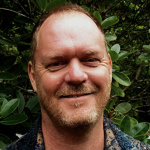
About David Nicol
The Eco-Institute at Pickards Mountain | My Experience as a Black Participant-Turned-Leader
The Eco-Institute at Pickards Mountain | My Experience as a Black Participant-Turned-Leader
Note: The Eco-Institute at Pickards Mountain is an Earth sanctuary and learning community dedicated to healing the human-Earth relationship. The educational farm resides on 28 acres in the Piedmont of North Carolina, eight miles west of Chapel Hill.
As I do believe in a higher power, it feels like divine intervention that my path has converged with the Eco-Institute’s —a hidden gem just 20 minutes from The University of North Carolina at Chapel Hill, where I received my undergraduate degree in May of 2020. While I was in college, I had no knowledge this space even existed before my friend Abbey participated in the Eco-Institute’s Rising Earth Immersion in 2019. It’s funny now to remember my thoughts about it at the time, including my absolute non-interest in convening with nature or being part of a farm community. I was happy for Abbey and the positive impact she had from the program, but thought, that’s not for me.
Nevertheless, as my college graduation approached, I found myself wondering how in the world I could pursue my future plans in the middle of an unprecedented global pandemic. Even more urgently, I wondered how I would sustain myself financially after losing my part-time job due to the pandemic, while also sustaining myself physically and mentally during this extremely stressful time. Five years of a hectic undergraduate schedule, including participating in the year-round consuming sport of Cheerleading for the school’s varsity teams, while regularly speaking out against systemic racism and police brutality as a campus activist and community educator, had already left me feeling worn down. This, in addition to spending the first half of 2020 trying to graduate during a pandemic, constantly grieving the murders of black people—my people—by an uncaring and unjust system, witnessing COVID cases and deaths climb each day—mounting the fears for the health and safety of myself and family—while also mourning the diseases’ disproportionate and deadly effects among black people, minorities and poor people, brought “burn-out” to a whole other level. I was nearly undone and in desperate need of space to heal from the unrelenting traumas and struggles of 2020. As I narrowed my focus on existing job opportunities, I was presented with the opportunity to apply for the position of Core Facilitator for the Rising Earth Immersion.
Processing Hesitations
I hesitated to apply for two reasons:
-
I’m a city-girl with chronic anxiety, and the idea of living among a bunch of bugs and animals that I usually assume will kill me has never excited me.
-
I was sensitive to the lack of ethnic diversity in the organization, and I feared being tokenized, unsupported, and misunderstood as the only black person in leadership.
However, after carefully reading the job description, the Eco-Institute’s mission statement, and seeing the expressed dedication to more decolonized education, inclusivity, intentional redirection of privilege for the purpose of shaping radical change and repairing Earth/human connections, I was encouraged to seriously consider this opportunity. Once I convinced myself that I most likely would not be murdered by some unheard-of species, I reached out to the Program Director, Alison Sever, to express my interest. After our interview I was even more interested in the opportunity, and I imagined the possibilities of what I could bring to the space with my own experiences and background, as well as what access to such a secluded, quiet, beautiful piece of land could offer me as a safe refuge for healing.
To prepare me for a leadership role, the Program Director, Alison, offered me a full scholarship to join for one season as a participant, while shadowing the facilitators and preparing to lead future cohorts. Again, I was hesitant…
Because I did not want to live in a yome, which is basically this room/tent thing in the woods,
Because, as a lower-income college grad, the idea of not working for five weeks was a bit unnerving,
And, because during this time of racial uprising and civil unrest, I felt guilty for retreating away to this beautiful space—like I was abandoning my duties as an activist.
Yet, I couldn’t deny what a privilege it would be to attend a $6,000 program that I knew I couldn’t have even thought about attending had it been any more than a couple hundred bucks.
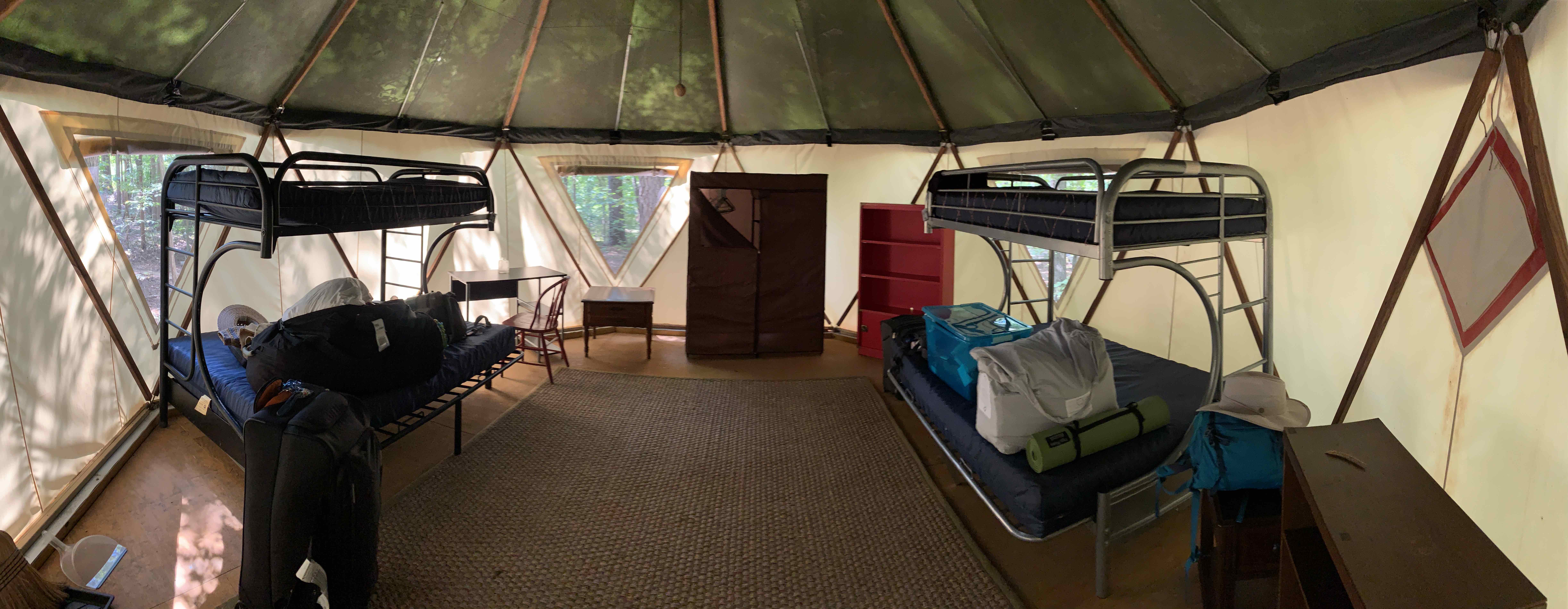
Then I realized that I owed it to myself, my people, and my ancestors to rest, and felt affirmed in remembering one of my favorite quotes by one of my favorite activists, Audre Lorde: Caring for myself is not self-indulgence, it is self-preservation and that is an act of political warfare.
Once I had the conviction that rest as a black woman is a revolutionary act and therefore my rest WAS essential to the current strivings for freedom, I set my mind on going and getting as much from this program as I possibly could. This still did not make the idea of staying in a wooden tent-like structure with no A/C in the middle of the summer more appealing, but the lease on my Chapel Hill apartment ended a day after the program was to start, and it was either a yome or my parents’ house. I figured I’d rather have the change in scenery.
Affirmation and Direction
Attending this program as a participant was more life-changing than I could’ve imagined. Its uniquely holistic curriculum revealed many missing pieces in my activism. Like that I’d neglected to recognize the extent of which social and ecological justice are connected. As a black woman, I found the land connection to be one of my greatest sources of healing. Not only did I feel a sense of connection to my ancestors through the acknowledgement of their spirit and labor within the soil, but even just the act of paying attention to nature grounded me. Tending to nature became tending to myself, and through the guidance of educational resources introduced to me through the Eco-Institute, such as Emergent Strategy, by adrienne maree brown, I’ve been able to observe in nature how to best interact with change through her perfect example of “adaptability, interdependence, decentralized power, resilience and transformation.”

The program also introduced me to various BIPOC-led organizations doing collective work rooted in activism, alchemy, liberation, land accessibility and ancestral connection. One of the most impactful encounters for me was with the Lead to Life collective in Oakland, CA, and their co-creator brontë velez. I was deeply touched by Lead to Life’s practice of melting weapons used in acts of violence to create gardening tools, offered to the families and communities affected, and used to plant new life at the sites of that violence. After expressing my persistent pain and rage from the events of 2020, brontë highlighted the power in leaning into healing and radically transformational work, rather than constantly focusing so much attention and anger toward the systems we are trying to dismantle. This was another point of affirmation, liberation and redirection for me: that through creating, we can also dismantle.
I soon became involved with an associated farm nearby in Chapel Hill belonging to a Congolese-American couple who have now become both mentors and spiritual guides to me. Through divination, ceremony, ritual, and biodynamics, they are teaching me how to heal, lead, and transform through honoring the interdependence of all life, both seen and unseen, and observing the magic of this divine plan.
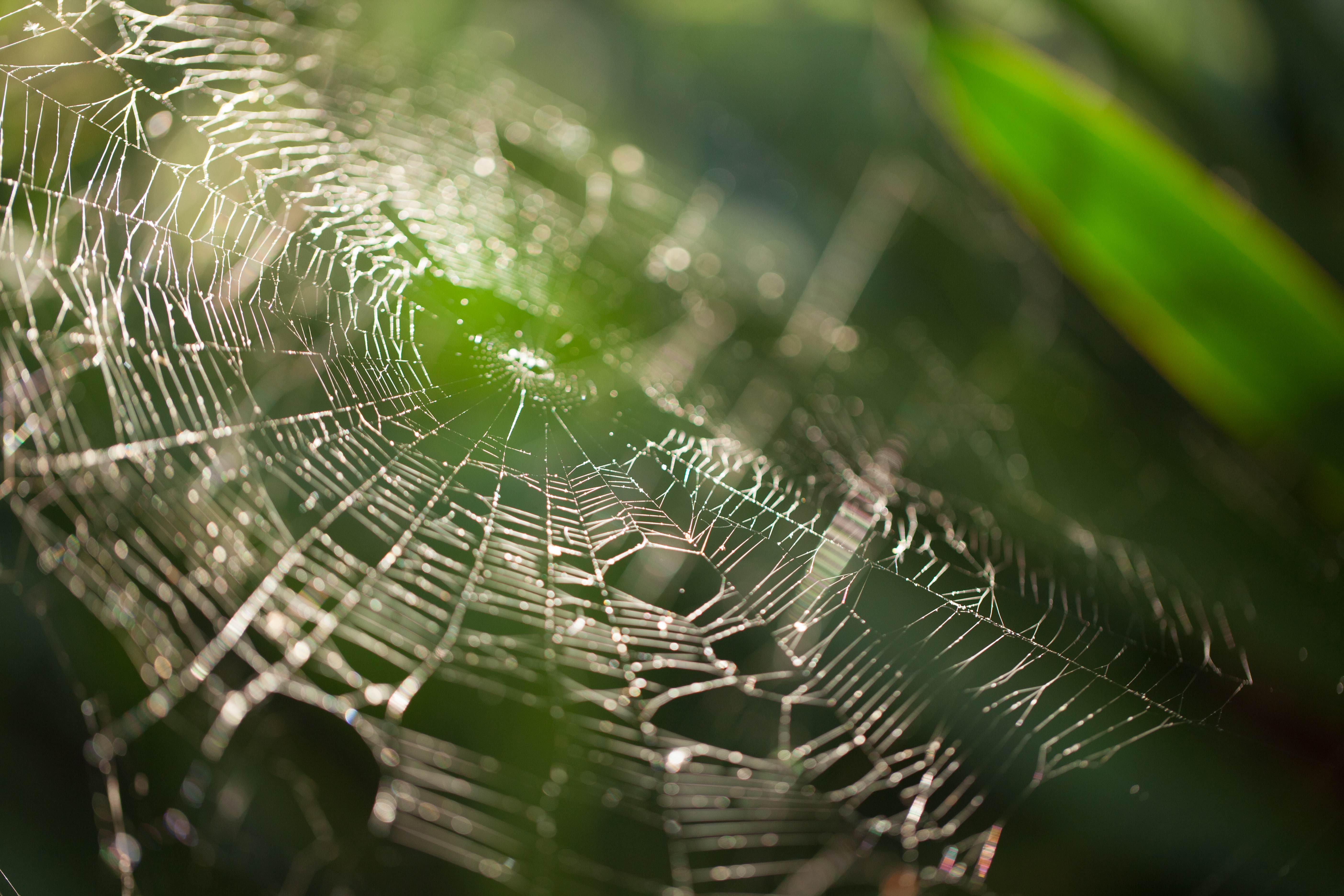
Interestingly enough, being around white people dedicated to allyship was a source of healing as well. It gave me a much needed glimmer of hope for the future of this country, and allowed me to examine how I wanted to show up as a historically marginalized minority in this program. I practiced taking up space, resting, being cared for and uplifted as a black woman, and maintaining my peace, while living in community with folks who are honest about the growth they have to do in the world of anti-racism. I carried all of this as I transitioned into being a facilitator the following season.
Co-leading a Rising Earth Cohort
My role as a facilitator of Rising Earth began in the Fall of 2020 with a 10-week immersion hosting 12 participants alongside my wonderfully supportive and insightful co-facilitator, Topher Stevens. Together we provided workshops around consent, community living, the impact of power structures and death culture, mindfulness, decolonization and imagination, self-care, and how to use one’s giftings for the common good. I facilitated healing spaces, specifically for people of color, which I felt were lacking during my time as a participant. All this while fostering better, more intentional allyship, and holding space for each individual of the group as a mentor and friend. These commitments create the foundation upon which we can confront challenges that arise within the cohorts. I know that some of the challenges we faced are common in other organizations and groups, so I will share them here. For example, the majority of the participants were white, young, and in the beginning phases of anti-racist work.
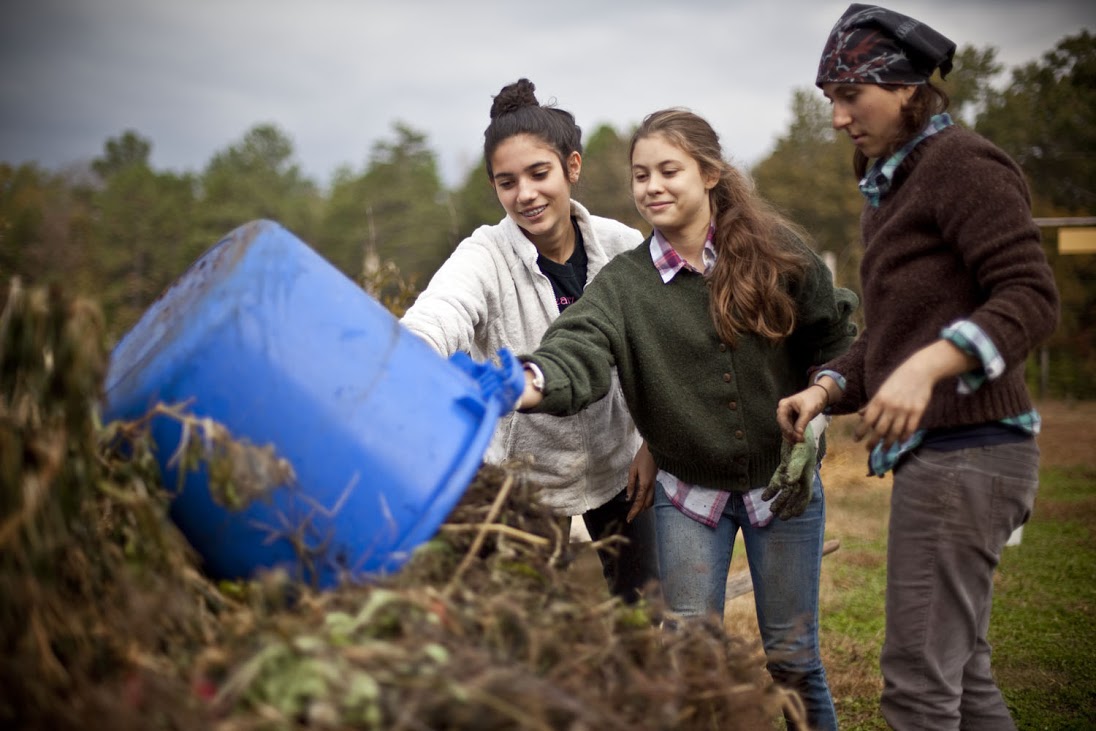
Our BIPOC participants, on the other hand, were heavily engaged with—and emotionally and physically drained from—years of anti-racist work, not to mention the reality of being BIPOC in a white supremacist society. To say the least, facilitation of this group was no easy feat! Instances of cultural appropriation, spiritual bypassing, indigenous erasure, poor accountability of privilege, and failure to be active anti-racist bystanders led to in-depth work addressing the harm and responsibility of white leadership, participants and the community alike. As a black woman who was also harmed by these experiences, to be able to show up fully for all members of the cohort and leadership team, it became even more crucial to create spaces for processing and healing for myself and other BIPOC participants, incorporating the practices of creating freedom from the inside out.
By the end of the program, I felt extremely fulfilled in seeing the growth of each participant as social and environmental justice warriors, change-makers, and more active anti-racist bystanders, but I was most proud in seeing the release and healing of BIPOC participants, made possible by the emphasis of rest, creation, unapologetic being and ancestral connection as necessary strategies to individual and collective liberation.
The fact that experiences like these are so largely unattainable to people of color because of our lack of generational wealth due to historical exploitation is devastating.
Even accessibility to nature in general is something that we don’t often have—in large part because of housing discrimination as well as our slim access to the very land our ancestors were forced to cultivate—pouring their blood, sweat, tears, and often their very lives into. I still struggle with feelings of anger and resentment around this reality because we deserve to heal and rest, and have spaces to be free to imagine and create a more liberated future. But I am grateful to be in the position I’m in now where I can help to bring that about for others as we continue to make this space accessible for all.
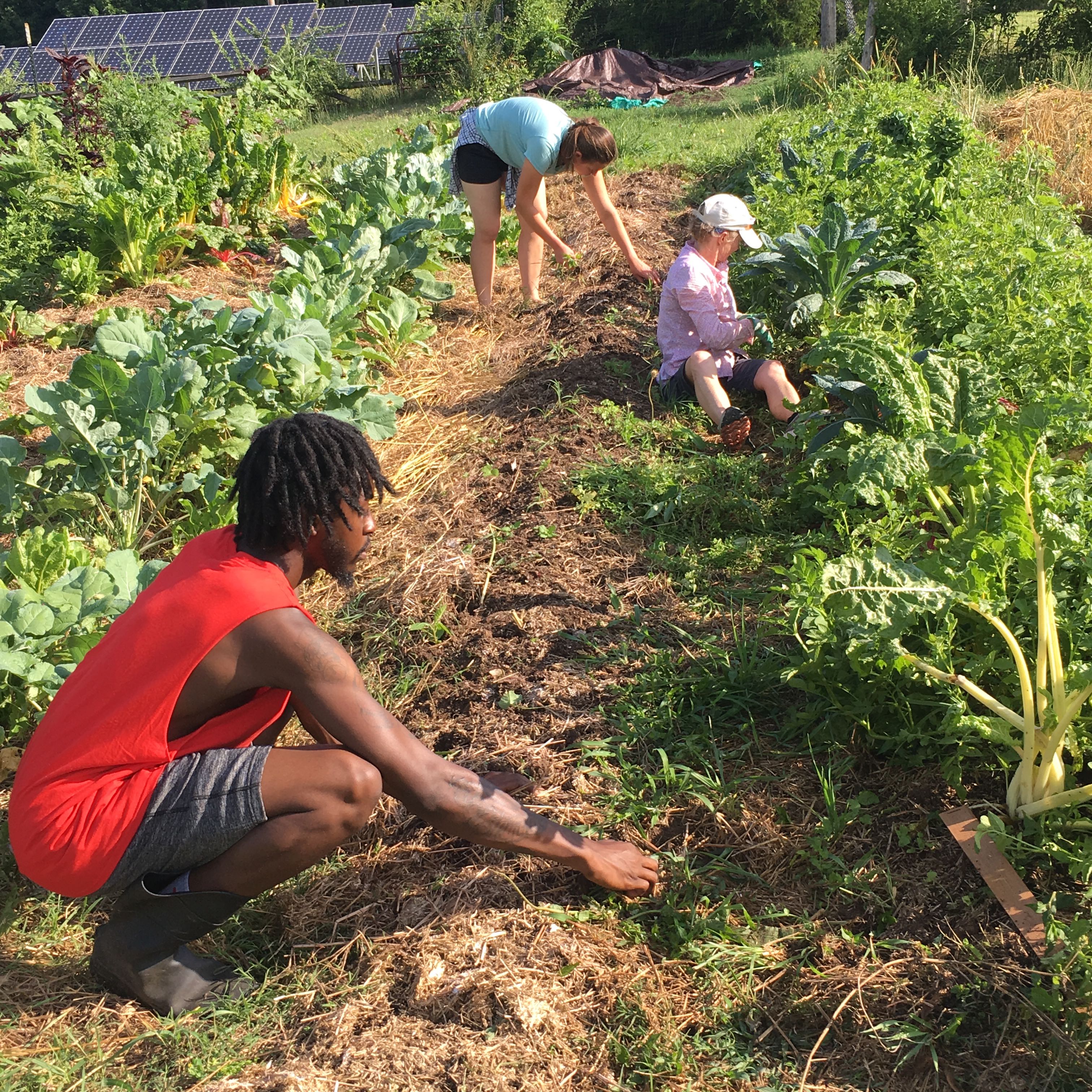
Future Building
I believe the impact that this program will have on the world through equipping young participants, of any racial identity, with holistic ways to reimagine and fight for their future is immeasurable. In revealing the destruction of land and Mother Earth to be largely linked to exploitative capitalism and colonialism, alumni of the program are now able to come from a holistic understanding to address climate change at its source. Through living in loving community with folks of various identities, while having real conversations about marginalized experiences and how we all experience white supremacy on a day-to-day basis—albeit differently—, Rising Earth alums from all backgrounds consistently develop more mindful, intentional, and radical allyship. In discussing self-care as an aspect of activism, alums are now able to recognize their needs on a somatic level and meet them in order to sustain themselves in this work. In linking community care to self-care, it is understood that since all life is connected, caring for others (human & non-human) is caring for oneself and vice-versa.
Lastly, when participants are facilitated in realizing their natural giftings when it comes to forms of service, they are better able to move in the world knowing how they can most efficiently and sincerely fight for the common good in their unique ways. It’s been amazing already seeing how graduates, equipped with new conversation skills, are having impacts in their own circles. From the white alums who are holding regular white caucus spaces to expand their capacities as more active allies, to the Black non-binary femmes who are finding better strategies for balancing rest and activism, to others leaning into creative film projects around Black expression and supporting food accessibility efforts—the updates I’ve gotten from the alums of this past fall cohort constantly have my heart beaming!
It is with utmost gratitude that I have been given the opportunity through this role to operate within my giftings as an activist, educator, creative, student, and healer in a way that has really confirmed my capacity to be a change-maker/change-shaper in this world. My hope is to continue doing this work while making spaces like this accessible to those who are most vulnerable and exploited in our society, and expressing the significance of being part of radically loving and spiritually-motivated community organizations like The Eco-Institute.
Photos | Courtesy Eco-Institute. except as noted
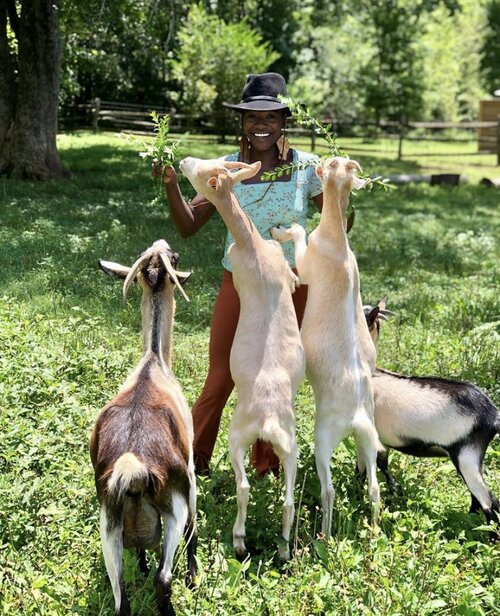
About Psalms White
Psalms is a creator, healer, activist, and educator with a passion for educating herself and others about Black history as American history, the impact of power structures on how we view the world, and how to self-care in the midst of these oppressive realities. A native of Charlotte, North Carolina, and a recent graduate of UNC Chapel Hill, Psalms has found great purpose in creating loving and supportive spaces for BIPOC folk, as well as helping others become better advocates for justice. In undergrad she founded Beta Nu Theta Service Fraternity which was dedicated to this purpose. Through her role as a Rising Earth Immersion Core Facilitator, she has been able to continue this work of helping participants realize how they can be of service to the world through their gifts/creativity, experiences, education, and growing consciousness of how we interact with systems of power.
Way of Council | Speaking and Listening from the Heart
What is Council Practice?
from Ways of Council
Council is an ancient way and modern practice whose roots are within the natural world, spanning diverse cultures and religions. This practice elicits an experience of true community, recognizing that each voice needs to be heard, that every person has a gift, a story to share, a piece of the whole. How do we remember all our relations, embrace differences, and find our own voices, while opening to others? It seems more than ever an essential time in our nation and around the world, to awaken this deep relational heart-mind.
Council offers a way of communicating that encourages attentive listening, as well as honest and compassionate expression. It makes room for new insights and understandings, wisdom in decision making, and healing. As a personal practice, a group process and a life-pathway, council is an intrinsic ingredient of our education at any age and especially important for families, guides, teachers, therapists, caregivers or any anyone whose work involves groups.
We have been drawn to the practice of council out of appreciation and respect for the wisdom tradition of First Nations and indigenous cultures that invariably included strong circle practices that were a seamless part of their life and relationship to the earth functionally, culturally and spiritually. We have been drawn to council because of its roots in these cultures, and the magic and healing that non-hierarchical circle communication can bring when practiced devoutly. In addition to appreciation for council’s timeless roots, we are drawn to council because it works. Speaking and listening from the heart can connect people authentically in a way that strengthens relationships, actually deepens relational consciousness and builds stronger communities. We have found that conflict exploration, co-visioning and decision making flow more productively in the council environment. Communication between intimate partners and in families flourishes more readily when council practice is embraced.
…excerpts from a session
Introduction by Jackie Parker
Twenty-five years ago, I created the Power of Our Stories workshops to help people of varying ages, backgrounds and experience share their stories deeply and freely, especially through writing. I had no idea that this process would become a way to bring people together in sacred community.
It was as if these stories were just waiting for the signal to spring forth into the world. For 25 years this has happened in every first gathering or workshop or class. I am still astounded.
It can feel natural and real or terrifying! With each meeting the masks drop off, the untold stories arrive: Moments of spiritual hunger and childhood shame. Moments of connecting to the Earth, of discovering their strength, often in early childhood. Difficult choices, tragedies met. Secret heroic acts. Beautiful, moving, courageous, and inspiring words are written and received in the workshops, creating families where we can be seen and blessed for who we truly are.
This is what you will see with the beautiful young men whose stories you are about to read. When the Circle was over, my co-leader Frank Phoenix and I were close to tears. “They really heard each other. They really want to hear each other. It’s a deep, deep longing, a deep, deep need. It takes us back to who we are,” Frank said.
I am humbled by the power our stories have to give voice to our hearts deepest truths. Even more by the ways they inspire and strengthen us to bring our powerful authentic selves to each other and into these times.
Editor’s Note: Circle Facilitators, Jackie Parker and Frank Phoenix have been hosting a group of young men, in collaboration with Kosmos, for an ongoing dialogue on the theme, Sacred Masculinity.
FRANK | Welcome. I became familiar with Way of Council about ten years ago. Andrew Cohen was a spiritual teacher, and he set up a structure for us to use as we were speaking: to set an intention for the sake of the whole, to follow the thread of the conversation and allow what was said to spark something in me, and speak spontaneously. And it was the first time I experienced how the collective became its own entity, or it really became the space for the Divine to show up. It became what I imagined Jesus meant when he said, “when two or more come together in my name, I am there.”
Prayer Circles
Frank Phoenix, called Byrd by his friends, has experienced countless circles. He currently hosts circles following Way of Council for Abundance NC called Stories of Grief and Healing. Another favorite practice of Byrd’s is making Prayer Circles, a form of meditation for Byrd and a way of honoring and connecting with Mother Earth and the Ancestors. Here are a few of Byrd’s circles.
JACKIE | There is no way to do this wrong. You may think, ‘oh, no, I shouldn’t say that’. Yes, you should say that. Just let it go. You be the instrument for your words. Okay. So here’s the prompt: Tell the story of a moment in your life when you discovered either your courage, your confidence, reverence for Life, or your thirst for union with the Divine.
(passage of time to gather thoughts and make notes)
DERRICK | Thank you for the prompt. The moment I wanted to speak about is the moment I decided to become sober off of alcohoI. Nobody else could make this decision for me. I had to make it for myself. I was living in a room, just by myself, kind of in a meditative state and it was almost like hearing a voice, a person’s voice. I was hearing my own voice, you know, like another side of me speaking that I could do this, it was in my own power. Those first few days, I felt extremely anxious, depressed, like the world was crumbling around me.
But I really found some strength in that. Three and a half years later, when I think about where I’ve come since then, it’s pretty amazing the decision that I made, how it affected the rest of my life. I was farming for a while and now I actually got into banking and I’m a retail banker.
STEVEN | Hard not to feel proud of you man and impressed. The courage and the discipline are so clear there – a clarity and a commitment that are really inspiring.
DERRICK | Thank you.
STEVEN | My first experience of reverence for Life was my first real encounter with death. A month before my 19th birthday my mother passed away after a three year struggle with ovarian cancer. Love had always been largely transparent to me and only vaguely gestured at by saying and hearing the phrase “I love you.” It became real witnessing myself caring for, and loving my mother at the end of her life.
My reverence for life was born in the many hours spent alone in the forest while I was beginning to process my grief. I didn’t know how to talk about my grief with others – I still don’t seem great at communicating about the parts I haven’t really integrated – but I didn’t need to explain my grief to the trees or the creek. I could feel the rough ripples and divots of tree bark and sense that I was accepted with all of my pain and joy. The more I retreated into the forest, the more my sense of self, with all of its stories, anxieties and pursuits gave way to an appreciation for, or perhaps an attachment to the timeless existence of life.
Currently, my attention is engaged much more with human affairs – the ups and downs of my marriage, my goals for my business or my family’s financial future, the news and politics. My engagement with nature is also dominated in this way, whether it’s an evening walk with my wife and dog or chopping wood so we’ll be comfortable next winter. I am accepting of these changes, sometimes even proud, but I can also feel how this way of being can pull me out of a deep core of reverence for life.
GENE | I’m also a Dad – I have a six year old. Since I met Jackie and we did the workshops, I’m writing a lot more. It’s helped a lot to bring some clarity into my life and some peace for sure. I’m very happy to be here despite finding it difficult to identify with courage or confidence. And I must say that very much fills me with sorrow and regret that I just can’t seem to find any of these in myself. I’m so scared that everything I’m doing will fail and everyone will be disappointed and I’ll be truly alone. I find myself looking up at the sky for answers to things I can’t find through hard work.
I think back to the time as a six year old boy, I realized how little I thought of myself as a person, that I was not someone who deserved to be hugged or acknowledged. I liked hearing people talk about how well I behaved despite not having a paternal figure. They praised me for sitting still and not expressing my desires. That boy wanted to be happy. And I think he’d be proud that I’m finally learning how to be, little-by-little, day-by-day. I hope he’d like to visit me and we could talk about all the things that he wants to say. And I can tell him how proud I am for having all that courage – to keep smiling.
STEVEN | That’s powerful. I see a few things in there that strike me – the vulnerability, which is courage. The humility, frankly, which is a hard thing to talk about. I think masculinity without humility is where we go wrong. I hear you parenting your younger self, right? There’s a way that you’re stepping into that fatherly role for a younger version of yourself. And for your own child. And that’s just really powerful, man. I’m really grateful that you shared.
BRANDON | Yeah, Gene, I felt while I was listening to you that we have this kind of vision of what sacred masculinity is and through hearing you talk, I realized how far away from that ideal I am myself as well. It’s like you said, a day-by-day, gradual process and humbling ourselves to realize where we’re at in this moment, but having that vision of who we want to be and to come together with other men to encourage each other. So thanks.
When I was 23 years old in the fall of 2015, I sat my first meditation course in a small town in Wisconsin. It was waking up at four-thirty in the morning and a pretty full schedule of meditation until the evening. There was a moment on the sixth or seventh day that would really change the course of my life forever. It was a really unshakable sense of peace and contentment that was as unconditional as any I had experienced.
This moment came and went, but others, similar moments like that were to come during this retreat and others that followed. And sometimes just in the midst of living, I found this place to be a deep well of creativity and insight into various aspects of my life and the world around me. I was starting to understand things in a deeper way, through this meditative state, and this moment was so powerful because it colored many aspects of what we are considering to be sacred masculinity, a reverence and a love for the beauty of the world around me.
DAVE | I met a man who became the most influential person in my life, this teacher, this author named Michael Singer. I felt inspired to start one of his courses. I would listen to one recording every night while I was laying in bed. At this time, I was completely obsessed with financial freedom and business and making money.
He showed me more clearly than anyone else had that the ‘dream life’ is like not actually what I wanted at all. I wanted money because I thought it would give me fulfillment a constant state of happiness and joy. But he taught me that I’m the cause of all my own suffering and problems and I’m not my thoughts or my emotions. I’m actually just the one experiencing them. It’s been a profound practice for me to objectify my thoughts. I was completely identifying with every single thought that would come up in my mind.
ARLO | I think that was spot on. I have experienced a lot of those emotions too.
I was working on this farm when I met this really cool dude named Robert. He played guitar and piano and he actually had a degree in opera, which I thought was badass. He really inspired me. There was another experience where I got to work up in Canada and I got to do this leader-in-training program. And there were these really cool, older counselors. And they were athletic and played music and were super playful. Another one was my boss. I feel like I take the traits that I admire in others and try to embody them and practice kindness. I’m a student of abundance and my skills and mindset have grown from that, I believe. And I understand now that young men have a need for role models and to learn from them.
So, these days I have younger men on my projects. And I almost feel like I’m in that new role of like being the role model. And that’s an honor. I’ve tried to learn from other men that model sacred masculinity and how to model that to others – just being a strong man, as well as an artist and a lover and a brother. That’s what the prompt brought to me.
JACKIE | I’ll let you in on something. These questions are designed to crack things open and you just did beautifully with them. Really, you are wonderful human beings. I’ve learned so much.
Special Thanks
Steven Lambeth, Founder, Family and Future – gourmet chocolate and nut butters.
Dave Pollmiller, Founder, Harvest Garden in Hawaii
Derrick Pickerill, Retail banker in Carrboro, North Carolina
Arlo Estill, Founder, Hempsmith Clothing Co
Brandon Schell, Homesteader and tiny house builder
Gene Arzube, Writer, student and dad
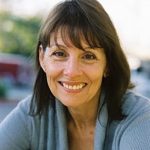
About Jackie Parker
Jackie Parker, the author of Our Lady of Infidelity: A Novel of Miracles, is an award-winning poet. She has written a bestselling young adult novel, Love Letters to my Fans, and a full-length play, Absentia and occasionally blogs for the Huffington Post.
Jackie has taught writing in schools and colleges, hospitals, living rooms, coffee houses, skyscrapers, nursing homes, conference halls, backyards, and front porches throughout North America—as far north as breathtaking Newfoundland. Her transformational workshops, The Power of Our Stories, use meditation and writing to bring creativity and community into the lives of people of all ages and backgrounds.
About Frank Phoenix
Frank Phoenix is called Byrd by his friends. His ancestors came to North Carolina from the British Isles 300 years ago. He was born a member of the Baby Boomer generation in Charlotte in 1952. He graduated from NC State in 1976 and worked for 24 years as an Environmental Engineer. Since 2000 Byrd has worked with the Fenwick Foundation where he grants funds to people and organizations working for a more beautiful world.
Ritual Fire and Sacred Masculinity
Ritual Fire and Sacred Masculinity
Amos Kamil | My name is Amos Kamil. I’m a therapist and a writer. And it’s my pleasure to be speaking with Christopher Henrikson of Street Poets in Los Angeles and Boysen Hodgson of The ManKind Project. Can you say a little about that, Boysen?
Boysen Hodgson | The ManKind Project is a 37-year-old nonprofit organization that started in the US and is now in 12 independent regions around the world. We primarily do two things—we run intensive weekend trainings for men and we support peer-facilitated men’s groups. We have around 750 men’s groups operating in the United States, plus men’s groups in 26 countries around the world. In 2004, I did the New Warrior Training Adventure Weekend, got into a men’s group shortly after that, and I have been in a communications role with The ManKind Project USA for 10 years now. So, I’ve actively participated in a profoundly life-altering and affirming circle of men for 17 years.
Amos | Excellent. And, Christopher, tell us a bit about Street Poets.
 Christopher Henrikson | Street Poets is a nonprofit organization here in Los Angeles that started in a juvenile detention camp in the LA County probation system. We harness the healing power of poetry and music to build community and create initiatory pathways for young people to step into purposeful adulthood. So, there’s some overlap with what Boysen is describing—rites-of-passage work and homecoming retreat work for people transitioning from one state of being to another and one place to another.
Christopher Henrikson | Street Poets is a nonprofit organization here in Los Angeles that started in a juvenile detention camp in the LA County probation system. We harness the healing power of poetry and music to build community and create initiatory pathways for young people to step into purposeful adulthood. So, there’s some overlap with what Boysen is describing—rites-of-passage work and homecoming retreat work for people transitioning from one state of being to another and one place to another.
Amos | In my practice, I see many men, and I’m always stunned when I asked them the question, “How many friends do you guys have, male friends?” And very often—I’d say 90 percent of the time—the answer is, “I don’t really have friends” or “Oh yeah, I got high school buddies I haven’t seen in 20 years.” Have the lives of men become more narrow socially? Are you seeing that?
Christopher | That’s happening. And then the opposite is happening too. The box that’s “traditional masculinity” has begun to break down and crack. There’s much more gender fluidity in our culture now. The old structures, modes, economic ladders, everything is kind of being swept into this current of change. So are those old ideas and old senses of identity around masculinity and male identity.
That said, what you’re describing is very much a reality, especially in a certain generation of men in our culture right now who are struggling to find a deeper sense of purpose. The suicide rate for men in their early fifties in our culture has been spiking in the last few years. So, I think that a lot depends on the age group that we’re talking about.
I work a lot with young men and boys coming into adulthood. They are entering a landscape that is kind of tabula rasa, you know? Those old pathways are not as clear for them anymore. And there’s a gift in that, as well as dangers and challenges that come with that.
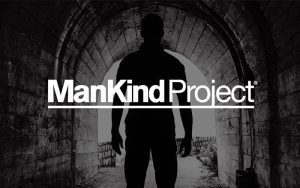 Boysen | That was really well said. At The ManKind Project, our “spot” for men has been those men who hear a call at midlife. A lot of the men that come to the organization are in their late thirties or in their early forties. They’re looking out at the landscape. They’re recognizing that all the stories they were told—about what they’re supposed to be, what they’re supposed to do, how they’re supposed to feel, how they’re supposed to hold it together—are all bullshit. Now what? “You told me if I did this, that I’d be happy and successful. You told me if I did this, that I would be a man. It’s not working. I feel lonely and isolated and disconnected from myself and disconnected from other men and disconnected from my kids.” There are a lot of men who come to the work who want to know how to love their kids better. They want to know how to love their wives better. They want to know how to be with their partners better, and they don’t have the skills. On some level, the work that we do at The ManKind Project is like remedial emotional intelligence work:
Boysen | That was really well said. At The ManKind Project, our “spot” for men has been those men who hear a call at midlife. A lot of the men that come to the organization are in their late thirties or in their early forties. They’re looking out at the landscape. They’re recognizing that all the stories they were told—about what they’re supposed to be, what they’re supposed to do, how they’re supposed to feel, how they’re supposed to hold it together—are all bullshit. Now what? “You told me if I did this, that I’d be happy and successful. You told me if I did this, that I would be a man. It’s not working. I feel lonely and isolated and disconnected from myself and disconnected from other men and disconnected from my kids.” There are a lot of men who come to the work who want to know how to love their kids better. They want to know how to love their wives better. They want to know how to be with their partners better, and they don’t have the skills. On some level, the work that we do at The ManKind Project is like remedial emotional intelligence work:
What are you feeling, man?
I don’t, I don’t know.
Well, how would you know what you’re feeling?
I don’t know.
What sensations do you have in your body?
I don’t know.
I have two teenagers. Tabula rasa is a beautiful way of saying it—it’s a blank slates to a degree. What I notice about teenage boys, especially, is that they are saying, ”Wait a minute. I’m still seeing all of these images in popular media of the tough guys and what it’s supposed to look like. And maybe it looks different than it did in the 1980s, but there’s still a lot of imagery out there that says I’m supposed to be this.” And on some level, we still don’t have a fully human vision of boys and girls, young men, young women, where we can all just embrace every aspect of ourselves.
Amos | You have both mentioned something interesting—that transition from boy to man. Why are initiation experiences essential to the transition from boy to man, or from midlife to elder?
Boysen | I think that liminal spaces give us permission to stretch outside of limitations that we’ve had, right? The trainings that we do in The ManKind Project remove you from your normal life and put you in a space where there’s a lot more heat than you’re probably used to, and then we see what happens with all of us together. We get permission to go deeper into our bodies and deeper into what’s going on with us than we might usually get. I think ritual is essential. And what Chris was saying about the transformative power of music and poetry and ritual—100 percent.
Christopher | I would add to that too. I came to this work through the portal of working with incarcerated youth and incarcerated boys, most of whom were gang affiliated. What you see with gangs is an attempt to fill a void in our culture, especially in inner city communities. It’s the only thing that you see there in terms of initiatory pathways for young people that has any structure, except that it doesn’t initiate them into adulthood or purposeful adulthood. It’s initiating them into a form of death or self-destruction.
What I realized was that in order to help someone transition out of gang life, their psyches needed to be engaged at that same depth level they engaged with when they were brought into the gangs in the first place.
And “death” is an essential element to that process. And I’m not necessarily speaking about literal death, although in some cases its presence is a part of that initiatory journey too.
I realized that I was trying to create a doorway for them out of a place that they had gone—you could call it the underworld; you could call it some kind of deeper, darker place. Poetry is one way to bring death and all its metaphoric and symbolic dimensions into the mix and into the conversation. For example, “What in you needs to die in order for you to continue to live in a bigger and broader way?” That question, to a teenage boy, is gonna get his attention.
Our culture has this profound baked-in fear of death because we have forgotten these rituals and these practices through the years. And we’ve forgotten how to bring death into our conversations, into our community spaces, and into our initiatory spaces in a way that opens up the potential for transformation.
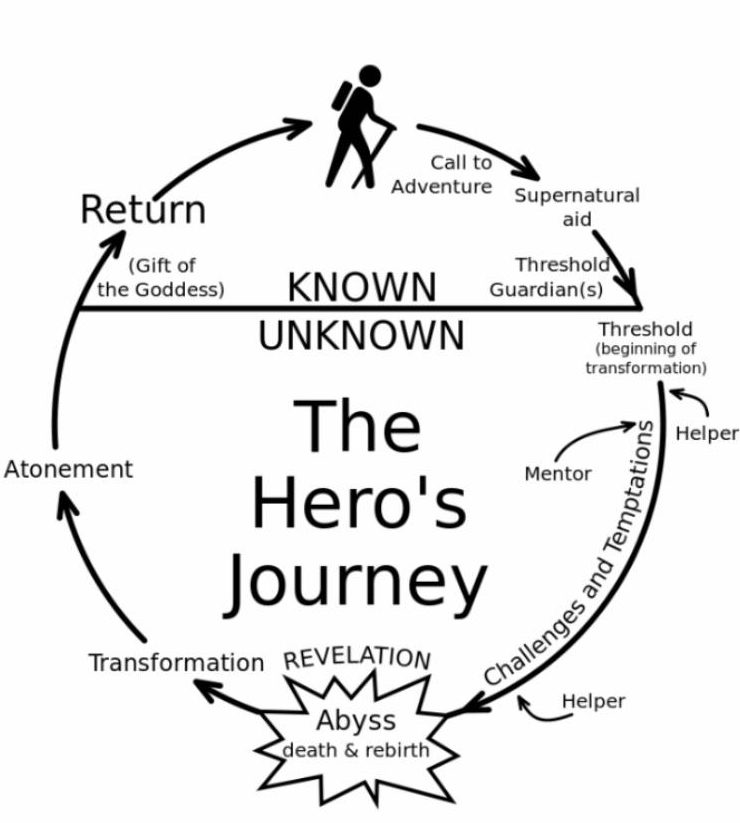 Amos | I’m really struck by the Hero’s Journey—that in order for you to be able to grow into the hero you’re meant to be, you have to leave the ordinary world, right? Whether that’s the gang or that’s the work life of a 30-year-old. Then bringing death in, you know, killing off a part of yourself becomes…resurrection.
Amos | I’m really struck by the Hero’s Journey—that in order for you to be able to grow into the hero you’re meant to be, you have to leave the ordinary world, right? Whether that’s the gang or that’s the work life of a 30-year-old. Then bringing death in, you know, killing off a part of yourself becomes…resurrection.
Boysen | And it’s not just death longing. That’s one, right? There’s the birth longing. The mother longing. The God longing. The father longing. Right? And bringing all of those into a place where it’s like, “Okay, you wanna create that? Good. Let’s create that right now, and bring that into the space.” And I think that’s the cauldron of ritual work, transformation work.
Amos | When I say the term “sacred masculinity,” what does it mean to either of you in the context of the work you do? Is this a useful term? Does it divide; does it unite? And what role has the sacred played in your own transformational experience?
Christopher | The word that comes to mind when I think of sacred masculinity is protector. And the image that comes to mind is of a tree, like a sentinel protecting the village, protecting the community, protecting those things that we think of as sacred and that need protection, that deserve our love and protection. What are the things at the heart of life that need to be protected? Sometimes, in our current culture and cultural dialogue, we lose track. For me, being somebody who stands up for justice, for what’s right, and taking care of those around us is a really essential aspect of that.
Boysen | Beautiful.
I did some etymology research, which is a fun place to start. Latin: sacer—to set off, to put boundaries around; sacred—something that is boundaried. That within here is sacred; outside of here is not. The “sacred masculine” idea of it is sometimes really difficult for me to chew on because I’m a heady guy, and I’m a modern man…. What is sacred? What is this?
But what I know is that it’s in those experiences, it’s in that liminal space, I feel something, right? There’s a bodily-felt sensation in this experience of sacred masculinity and the experience of sacred femininity. It is set off from everything else. It’s different. It’s a different space, different time.
And—yeah, I’m bringing God into the conversation—Robert Bly talked a lot about verticality—that something that was really missing in our culture was grounded into the deep earth, into the mud (Jungian, shadow work, archetype work), and connected to the vertical expansive, infinite, possible. That verticality has sacredness to it. So, though I have no belief in a God, I have a belief and understanding and felt-sense of something sacred.
Christopher | And it may be just for me—the sacred masculine has an aspect of fire to it. And in our culture, as you know, we have too much fire. There’s so much violence and addiction, and these things are indicators of fire out of balance or control. But when we think about what fire looks like in balance, it’s that vertical fire in the center of the village that warms everyone, the fire through which we connect with each other, to those who have passed, to our ancestors.
When I think about sacred masculinity, it’s that kind of ritual fire at the heart of the ritual space or liminal space.
Amos | How would you say that the work you’re doing, serving the emotional needs of men, how does it ripple out? How does it impact society at large? And what roles beyond, you know, breadwinner and warrior are you putting forth as another color to paint with in the palette?
Boysen | Um, lover. Nurturer, magician in the kind of Jungian archetypal sense, alchemist.
Christopher | Healer.
Over the last 15 years or so, I’ve been up maybe nine or ten times to Mendocino, California, for the Mosaic Multicultural Foundation Men’s Retreat. Michael Meade is the chief convener of that, and the late Malidoma Somé, Jack Kornfield, Luis Rodriguez who’s a poet and an elder in our Street Poets community, and many other wonderful men. One of the things that comes up every year is how the women in their lives, when the men are preparing the retreat, get a little anxious, like, “What’s going on?” They want to know. But the men who return year after year say their partners are now like, “Go, go.” They’re like kicking them out the house.
Because they know that when they come back, they’re gonna be more present. They’re gonna be more grounded. They’re gonna be more connected to their hearts. They’re gonna be more able to show up for their partners in ways that are more compassionate, more tuned-in to their own sacred feminine as well, and to the creative sides of themselves and their full dimensionality. So, I think there’s a massive ripple effect that men’s work, in general, can have on the culture as a whole.
Boysen | We do homecomings after the New Warrior Training Adventures where we invite friends and family. And there’s a period of time when we ask partners and friends and family to stand and say something about what has happened when their man has gone through this experience. Wives and partners come and face the man who went off into the woods for this experience to say, “When you came home, I looked in your eyes and there you were! You were there. That’s the man I fell in love with. That’s the man I knew you could be, that got lost so long ago.”
My wife knows who I am. She knows when I’m here. And she knows when I’m not. Doing men’s work helps me be here.
Amos | How do you incorporate a wider palate of what it means to be a man into your work?
Boysen | Continuing to grow and change. It’s a very alive conversation, and I’m grateful. I thought I had a handle on this stuff 10 years ago. No way. The amount of evolution today and how fast it is moving, I come back and keep saying, “Oh my God, I used to think that was fixed. I had a perspective on that.” Now I look out and it’s like, “Wow, I don’t have to have a perspective on that.” It’s being created right in front of me. It’s being created by 14- and 15- and 16-year-olds right in front of me.
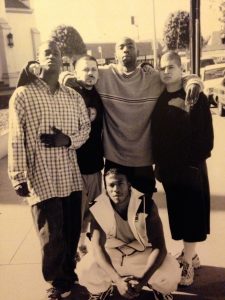
Christopher | The metaphor that we work with a lot at Street Poets is that of a river, a rushing river. Whenever you’re in the rapids and you try to grab onto things or keep things the way that they’ve been, it creates more suffering generally. A lot of my personal practice and the practice of our community has been a practice of letting go of old ideas, old ways of looking at things and surrendering to the flow of that river. Allowing new ideas, new ways of showing up in the world to present themselves and to be open to learning from them.
The fluidity that exists in the culture right now around gender identity, and really in almost every area, has been an ongoing practice of surrender and staying open, curious about where we’re headed as a humanity.
I think we all know on some level that radical change is necessary in our culture in many ways and many areas. And evolution is something we want to invite in. So, part of that is just keeping our hearts and ears open to what new information is presenting itself.
Amos | I love that image of the raging river, and it actually leads me to the next question. Our screens right now are filled with horrible images of the Russian invasion of Ukraine, right? You can’t avoid it, and that’s sort of, you know, masculinity run amuck. Chris, you were talking before about the fire out of balance—being used to destroy. Does authoritarianism and its rise in the world reflect an imbalance in masculine energies?
Christopher | Yeah, absolutely. I think you’re seeing shadow masculinity.
Fascism, authoritarianism is masculinity run amuck. War and the military industrial complex still, in many ways, dominates the physical world. One way of looking at it is it’s in its final death throes on some level. At least that’s the way I’m choosing to look at it.
But let’s hope that those death throes don’t kill us all, right? There’s the potential, anytime you’re dealing with the kind of change we’re dealing with, that those forces are gonna rise up more strongly than ever and surface so that they can be addressed, dealt with, and seen more clearly.
We’re seeing some really obvious examples, both in our own leadership in the past six, seven years and clearly in the Russian leadership and other governments as well. The rise in fascism is a symptom of something that needs to be surfaced in order for us to address and transform it. But I’m not sure that means that Putin’s going to go through some magical transformation himself on a personal level. It may be more about what happens beyond him.
Amos | We’ve had a very fractured American society during the last six or seven years. How do you guys incorporate different political views into your work?
Boysen | With great difficulty is what I would say. I think that the pandemic has exacerbated that problem a lot. I’ve sat with men who have wildly different political views than myself for many years. And being in the pandemic, I haven’t been able to sit in a circle with these men and really sense them. And so what am I left with? I’m left with my head games. I’m left with my stories. I’m left with the echo chambers of the kind of news and media and messages that I get. And they’re left with the echo chambers of the kind of news and media they get. And then out of all of that beautiful Jungian shadow work, we’re projecting it all over each other—making one another “bad,” making one another “evil.” Men have hardened me into perspectives that I don’t even hold. And I’m sure that I have hardened them into perspectives that they don’t even hold. Schizogenesis is the word for that, right? We define ourselves in opposition to others.
Christopher | I’m going back to that river and fear—there’s a lot of fear in our culture right now. And, whenever fear is on the rise, it’s natural to reach for black and white answers and even authoritarian leaders who say they have all the answers. It’s important to have compassion for people who make choices ruled by fear. Some of my fear may be reduced because of the people that I’m surrounded with on a daily basis and have intimacy with. Other people don’t have the luxury of being in those same circles and spaces. Boysen’s absolutely right—all of these things have been exacerbated by our isolation from each other over the last couple years and our dependence on things like social media, sadly, to figure out how and what we’re supposed to think.
Amos | For many years, I’ve been an advocate of National Service. So that the kid from, you know, Compton gets to meet the kid from Nebraska. It doesn’t necessarily need to be toward the military; it could be planting trees. It could be visiting old age homes. But the notion that you’re giving up something for the broader society could do a lot. I don’t understand why this country doesn’t have it. It seems like something that everybody could agree with.
How about a little bit of a different tack here? I think you are both familiar with my work exposing sexual abuse in the world. How have the abuses in private schools, academic religious schools, the Catholic church, the Boy Scouts impacted the men you serve? What’s being done at your organizations to protect men from these abuses? And have you noticed a change in, let’s say, the last 10 years where people are actually speaking about it more? Has there been a shift?
Boysen | I see Chris nodding also. Absolutely. And what I see is a growing willingness over the last couple of decades for the many men who have experienced childhood sexual abuse to come forward in a way that they hadn’t before. And I think that opens the possibility for more men in our culture to believe women and to hold a compassionate perspective for what they’ve gone through. It also brings more accountability when men are no longer denying and hiding the things that happened to them or the things that they did. It creates more accountability in the culture, which, I think, is what we need to break through.
Christopher | Big yes. To everything you just said, Boysen. And yes to your question as well, Amos. The de-stigmatization of the childhood sexual abuse wound in males, particularly, is something that has been dramatic and continues to be a sign of really positive change in our culture over the last 5, 10, 15 years. Working with gang members here in Los Angeles for the past 25 years, that’s been the final threshold kind of wound in terms of the transformational journey for a lot of them.
I would be shocked if it wasn’t something close to 75 percent of them who have been abused sexually as children or, in one way or another, had that boundary crossed.
And it’s rare that they’re able to begin unpacking that until, in my experience, they get into their twenties. It’s a very unusual teenager who can start to unpack that when they’re still in that hormonal shift and struggling to figure out their sense of identity. So, in our experience, it’s folks that we’ve worked with for 10 years, maybe since they were 14, 15, who begin to get around to that layer of themselves in their mid- to late-twenties.
I think as a result of the work that people like you have been doing, Amos, to shine a light on these larger incidents, it’s actually opened the door for people at a younger age to begin to talk about this. And more high-profile folks are speaking about their own abuse. It feels like things are shifting in a really positive direction there. So it’s something we can feel good about as a culture, I think.
Amos | Yeah. Thanks for saying that. In terms of your statistics, that’s really young for them to be talking. The average male, if he speaks at all, and this is statistics, is usually in his fifties.
Christopher | Wow.
Amos | And women, in their forties. My hope is that that goes down too, very soon. That’s why the statute of limitations laws were so outlandish and draconian, because they would end after somebody turned 21 in a lot of the states.
Christopher | When you’re working with brown and black males who have come with a gang background, it may be a matter of life and death whether they talk about it. It gets to a point where it’s like, “I’m either gonna die or spend my life in prison behind this stuff if I don’t apply these principles I’ve learned in the beginning of my healing journey to even this wound as well.” Because of the culture that we live in and the imbalances in that culture, there’s an urgency that exists, I think, in some of the more traumatized black and brown youth and young adult males that isn’t necessarily the case with these older white males who might still be able to function in society to whatever degree. It may take those white males until their fifties to recognize, like, “Wait, I’ve gotta address this.” And maybe it’s their first glimpse of their own mortality that begins to activate that awareness. Sadly, many young brown and black males in our culture, they’re confronted with their own mortality when they’re 10, 12, 13 years old. Death is already in their face. I think that difference may inform some of those statistics.
Amos | Interesting. I hadn’t looked at it that way. I don’t have the numbers in front of me, but that makes sense. What’s the most important message about masculinity that families, women in general, kids, and society need to hear?
Boysen | Some women in our culture, even though we all know that men are whole human beings and that men have emotional lives and depth and that men have vulnerability and fear, would rather die than see them knocked off the white horse. It’s terrifying for them to imagine a world where men are not rigidly holding themselves together and stoically pushing through, sacrificing themselves, right? It’s a scary proposition to say, “Oh, men are actually fully human and vulnerable and loving and nurturing and soft and tender and tough and strong and willful and aggressive and all of these things.” So that’s one that I think is really big. Lower the barriers, and allow men to come down off of those pedestals so that we can actually be here together.
Amos | Chris, how about you? Who are these teens-to-men, and what needs to be known about them?
Christopher | We talk about men and women, masculinity, femininity, the sacred masculine, the sacred feminine, and need to recognize that we all have all of these in us. So you can be a woman who’s very connected to her sacred masculine and shows up in the world very much that way. And vice versa, you can be a man who’s very connected to his nurturing, creative spirit. The more we begin to take it out of that binary place and into this more fluid place, following the lead of our young people is good. What does it mean to show up in a healthy, masculine way, and what does it mean to show up in a healthy, feminine way?
And that those things are not necessarily connected to the bodies into which we were born but are more about aspects and dimensions of our being. You can look at the Hindu gods and deities that have aspects of both masculine and feminine and show up in both ways. And in a lot of Indigenous cultures, the gatekeepers of ritual are the members of the community that are “two-spirited”—that have both aspects. So I think that’s where we’re headed.
And I have enormous respect for the work that The ManKind Project does. I’ve known many folks that have been beneficiaries. The vision and scale of The ManKind Project is remarkable to me. And important in a culture that has forgotten a lot of these things. So, thank you.
Boysen | Thank you, Chris. I’m just getting to know the work you do with Street Poets. Poetry and music—I don’t think there’s healing without it.
Amos | Thank you both.
Back to Earth
There is a place in between
What you and I call reality
Where a fire burns
Rainbow bright
Even in the darkest night
Rattles dance
Nature’s masquerade
As we offer old pains to the flames
There are names that we’ve forgotten
A language we’ve lost in our journeys
Into blame, seeking fame
We cast spells on ourselves
That erase our ancestors’ trail home
So I bury my roots here
Where four seasons circle the sun
Where leaves change colors
Where grass can be green or golden
The wind blows and the rains shower
Where the land provides
For all that give back to it
For all that are willing to take
Only what they need
Deep blue oceans and lakes teeming with trout
Snow-capped mountains and valleys laced with life
Where you can build a cabin and live in peace
Sip your coffee
Read a good book
Write poems on leaves lifted by the wind
Spinning directions
To reach the lost ones
And remind them
How others can get here
How they too can find a way back to earth
-Jorge Nunez
Former Student & Current Teaching Artist
Street Poets Inc.
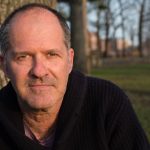
About Amos Kamil
Amos Kamil, MFA, MSW, LSW, is an author and psychotherapist who works with men, couples, and adults recovering from trauma and abuse. In his work, he draws on Family Systems, CBT, DBT, Internal Family Systems, and the Gottman Method.
In addition to his clinical work, Amos is a playwright, screenwriter, and investigative journalist. His play, The Flame Keeper, ran off-Broadway for five and half months, has been performed regionally, and translated into German, French, Italian, and Hebrew. His work has also appeared in numerous media outlets including The New York Times, The Jerusalem Post, Newsweek, The Jerusalem Report, Good Morning America, ABC, NBC, TNT, and ESPN.
He earned his Master’s in Social Work from New York University and a Master’s in Fine Arts from the American Film Institute.
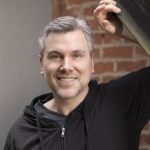
About Boysen Hodgson
Boysen Hodgson is Communications & Marketing Director for The ManKind Project USA. He is the author of “The New Macho,” a 21st century credo for the mature masculine, and a co-creator of MKP’s “The Men’s Work” 3-week course. He’s on a mission to transform culture with nearly two decades’ experience nurturing emotionally-grounded, accountable, and purpose-driven men.
Boysen completed the New Warrior Training Adventure in 2004. He lives in Springfield, Massachusetts, with his wife, Kendra. He’s a dedicated husband and a proud adoptive dad. Contact Boysen: communications@mkpusa.org.
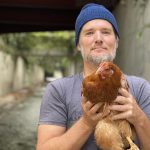
About Chris Henrikson
Chris Henrikson is the founder and executive director of Street Poets Inc., a Los Angeles-based nonprofit organization that harnesses the healing power of poetry and music to inspire our next generation to write, rap, and dream a new world into being for us all. His work includes facilitating youth initiation retreats and homecoming retreats for California State Prison parolees and serving as producer of the Street Poets Podcast. For more on Street Poets, visit streetpoetsinc.com.

